Paul van Yperen's Blog, page 324
December 17, 2016
Peer Schmidt
Dark-haired Peer Schmidt (1926-2010) was a German actor, on stage from 1946. He was popular on screen during the 1950s, 1960s and 1970s in romantic roles, or as sympathetic innocents and dreamers. He was also the German voice of Gérard Philipe, Marlon Brando and Jean-Paul Belmondo.

East-German postcard by VEB Progress Film-Vertrieb, Berlin, no. 1209, 1959. Photo: publicity still for Bekenntnisse des Hochstaplers Felix Krull/Confessions of Felix Krull (Kurt Hoffmann, 1957).

Austrian postcard by Verlag Hubmann (HDH Verlag), Wien, no. 81. Photo: Unionfilm, Wien. Publicity still for Der Zigeunerbaron/The Gypsy Baron (Kurt Wilhelm, 1962).
Upright, a little naive, partly dreamy and clumsy
Peer Eugen Georg Schmidt was born in Erfurt, Germany, in 1926. Schmidt's father was a painter. Peer grew up in his hometown of Erfurt. In Berlin, he took acting lessons, but he had to stop with lessons due to military service during the Second World War.
After 1945, he played in theatres in Berlin, Frankfurt, Munich and other German cities, but also in Zurich. Between 1946 and 1955 he worked under Gustav Gründgens in Düsseldorf.
In 1953, he made his film debut at the side of Johannes Heesters in Liebeskrieg nach Noten/Love War for notes (Karl Hartl, 1953). He also appeared opposite Hardy Krüger and Ruth Leuwerik in Muss man sich gleich scheiden lassen?/Do you have to divorce? (1953).
More supporting roles followed which made him known to a wider audience. In total he appeared in more than 40 films, including Junger Mann, der alles kann/Young man who can do anything (Thomas Engel, 1957) with Georg Thomalla, Bezaubernde Arabella/Charming Arabella (Axel von Ambesser, 1959) starring Johanna von Koczian and Carlos Thompson , and Lemkes sel. Witwe/Lemke's Widow (Helmut Weiss, 1957) with Grethe Weiser.
He often played good-natured, upright, a little naive, partly dreamy and clumsy men and adventurers. In Bekenntnisse des Hochstaplers Felix Krull/Confessions of Felix Krull (Kurt Hoffmann, 1957), based on the novel by Thomas Mann, he played Marquis de Venosta whose identity Krull ( Horst Buchholz ) assumes.
Schmidt had another notable appearance in the international production Monte Carlo or Bust!/Those Daring Young Men in Their Jaunty Jalopies (Ken Annakin, 1969) about a car rally in the 1920s. This comedy, featuring an all-star cast including Gert Fröbe and Tony Curtis, is a sequel to the hit Those Magnificent Men in their Flying Machines (Ken Annakin, 1965). Monte Carlo or Bust! was a success among audiences and critics alike.

German postcard by Kunst und Bild, Berlin, no. A 1385. Photo: Dörfler-Film / Deutsche London / Ewald. Publicity still for Der doppelte Ehemann/The double Husband (Ferdinand Dörfler, 1955).

German autograph card. Photo: Lars Looschen.
The German voice of Jean-Paul Belmondo
From the 1960s Peer Schmidt also intensely worked as a voice actor. He lent his distinctive voice to Gérard Philipe in such films as La Chartreuse de Parme/The Charterhouse of Parma (Christian-Jaque, 1948) and to Marlon Brando in A Streetcar Named Desire (Elia Kazan, 1951), and Rod Taylor in The Time Machine (George Pal, 1960).
Between 1959 and 1975 he often dubbed Jean-Paul Belmondo , such as in Au bout de souffle/Breathless (Jean-Luc Godard, 1960) and Cartouche (Philippe de Broca, 1962).
In the meantime, he also played in several television productions. A huge success was his title role in Der kleine Doktor/The Nature Doctor (Wolfgang Becker, 1974) based on the stories by Georges Simenon. Other TV series were Cafe Wernicke (Herbert Ballmann, 1978) with Johanna von Koczian , and Die Laurents/The Laurents (Erich Neureuther, 1981) with Mathieu Carrière.
However Schmidt felt most at home in the theatre. His favourite stages were the Berlin boulevard theatres, Renaissance Theater, Theater am Kurfürstendamm and Komödie.
From 1966 until his death Peer Schmidt was married with the actress Helga Schlack. Peer Schmidt and his wife lived alternately in Berlin and on the North Sea island Amrum. Schmidt died in 2010 in a Berlin hospital. He was 84.

German postcard by Franz Josef Rüdel, Filmpostkartenverlag, Hamburg. Photo: H. Schlack.

German postcard by Münch, Göttingen. Photo: H. Schlack. Signed in 1990.
Sources: Stephanie D’heil (Steffi—line - German), Wikipedia (German and English), and .

East-German postcard by VEB Progress Film-Vertrieb, Berlin, no. 1209, 1959. Photo: publicity still for Bekenntnisse des Hochstaplers Felix Krull/Confessions of Felix Krull (Kurt Hoffmann, 1957).

Austrian postcard by Verlag Hubmann (HDH Verlag), Wien, no. 81. Photo: Unionfilm, Wien. Publicity still for Der Zigeunerbaron/The Gypsy Baron (Kurt Wilhelm, 1962).
Upright, a little naive, partly dreamy and clumsy
Peer Eugen Georg Schmidt was born in Erfurt, Germany, in 1926. Schmidt's father was a painter. Peer grew up in his hometown of Erfurt. In Berlin, he took acting lessons, but he had to stop with lessons due to military service during the Second World War.
After 1945, he played in theatres in Berlin, Frankfurt, Munich and other German cities, but also in Zurich. Between 1946 and 1955 he worked under Gustav Gründgens in Düsseldorf.
In 1953, he made his film debut at the side of Johannes Heesters in Liebeskrieg nach Noten/Love War for notes (Karl Hartl, 1953). He also appeared opposite Hardy Krüger and Ruth Leuwerik in Muss man sich gleich scheiden lassen?/Do you have to divorce? (1953).
More supporting roles followed which made him known to a wider audience. In total he appeared in more than 40 films, including Junger Mann, der alles kann/Young man who can do anything (Thomas Engel, 1957) with Georg Thomalla, Bezaubernde Arabella/Charming Arabella (Axel von Ambesser, 1959) starring Johanna von Koczian and Carlos Thompson , and Lemkes sel. Witwe/Lemke's Widow (Helmut Weiss, 1957) with Grethe Weiser.
He often played good-natured, upright, a little naive, partly dreamy and clumsy men and adventurers. In Bekenntnisse des Hochstaplers Felix Krull/Confessions of Felix Krull (Kurt Hoffmann, 1957), based on the novel by Thomas Mann, he played Marquis de Venosta whose identity Krull ( Horst Buchholz ) assumes.
Schmidt had another notable appearance in the international production Monte Carlo or Bust!/Those Daring Young Men in Their Jaunty Jalopies (Ken Annakin, 1969) about a car rally in the 1920s. This comedy, featuring an all-star cast including Gert Fröbe and Tony Curtis, is a sequel to the hit Those Magnificent Men in their Flying Machines (Ken Annakin, 1965). Monte Carlo or Bust! was a success among audiences and critics alike.

German postcard by Kunst und Bild, Berlin, no. A 1385. Photo: Dörfler-Film / Deutsche London / Ewald. Publicity still for Der doppelte Ehemann/The double Husband (Ferdinand Dörfler, 1955).

German autograph card. Photo: Lars Looschen.
The German voice of Jean-Paul Belmondo
From the 1960s Peer Schmidt also intensely worked as a voice actor. He lent his distinctive voice to Gérard Philipe in such films as La Chartreuse de Parme/The Charterhouse of Parma (Christian-Jaque, 1948) and to Marlon Brando in A Streetcar Named Desire (Elia Kazan, 1951), and Rod Taylor in The Time Machine (George Pal, 1960).
Between 1959 and 1975 he often dubbed Jean-Paul Belmondo , such as in Au bout de souffle/Breathless (Jean-Luc Godard, 1960) and Cartouche (Philippe de Broca, 1962).
In the meantime, he also played in several television productions. A huge success was his title role in Der kleine Doktor/The Nature Doctor (Wolfgang Becker, 1974) based on the stories by Georges Simenon. Other TV series were Cafe Wernicke (Herbert Ballmann, 1978) with Johanna von Koczian , and Die Laurents/The Laurents (Erich Neureuther, 1981) with Mathieu Carrière.
However Schmidt felt most at home in the theatre. His favourite stages were the Berlin boulevard theatres, Renaissance Theater, Theater am Kurfürstendamm and Komödie.
From 1966 until his death Peer Schmidt was married with the actress Helga Schlack. Peer Schmidt and his wife lived alternately in Berlin and on the North Sea island Amrum. Schmidt died in 2010 in a Berlin hospital. He was 84.

German postcard by Franz Josef Rüdel, Filmpostkartenverlag, Hamburg. Photo: H. Schlack.

German postcard by Münch, Göttingen. Photo: H. Schlack. Signed in 1990.
Sources: Stephanie D’heil (Steffi—line - German), Wikipedia (German and English), and .
Published on December 17, 2016 22:00
December 16, 2016
Imported from the USA: Keanu Reeves
Keanu Reeves (1964) is a Canadian actor, producer, director and musician. Though Reeves often faced criticism for his deadpan delivery and perceived limited range as an actor, he nonetheless took on roles in a variety of genres, doing everything from introspective art-house fare to action-packed thrillers. His films include My Own Private Idaho (1991), the European drama Little Buddha (1993), Speed (1994), The Matrix (1999) and John Wick (2014).
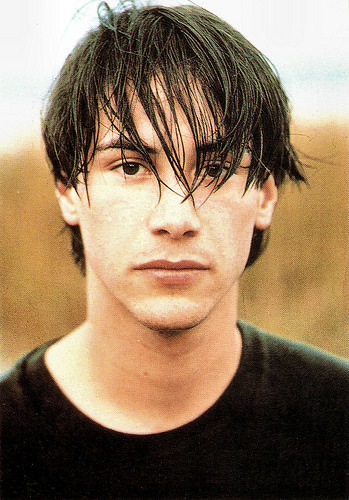
Vintage postcard, no. C 445.
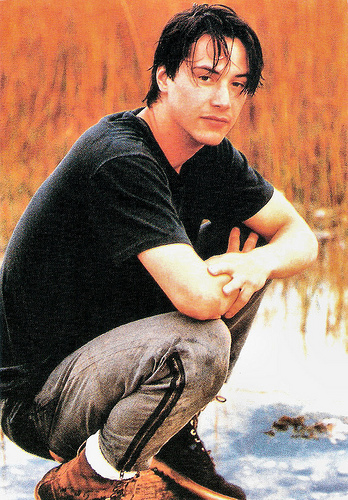
British postcard, no. MM373.
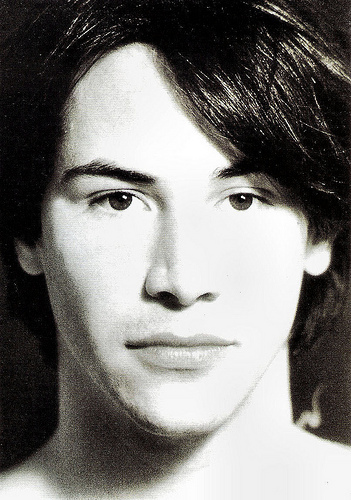
British postcard by Heroes Publishing Ltd., London, no. SPC 3017.
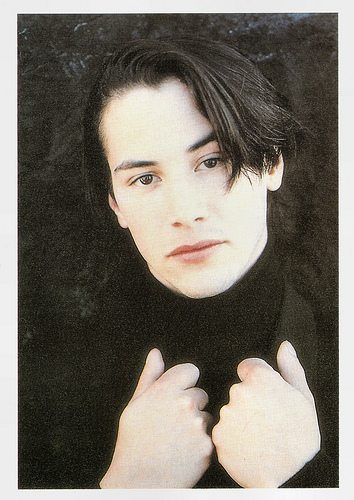
Spanish postcard by Coleccion Estrellas Cinematograficas, Cacitel, no. 73.
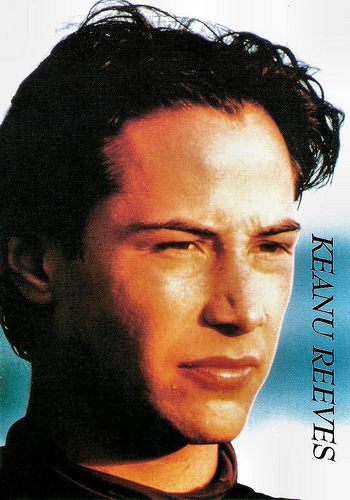
British postcard, no. MM371.
Cool breeze over the mountains
Keanu Charles Reeves was born in 1964, in Beirut, Lebanon. His first name means ‘cool breeze over the mountains’ in Hawaiian. His father, Samuel Nowlin Reeves Jr., was a geologist of Chinese-Hawaiian heritage, and his mother, Patricia Bond (née Taylor), was a British showgirl and later a costume designer for rock stars such as Alice Cooper.
Reeves's mother was working in Beirut when she met his father. Upon his parents’ split in 1966, Keanu moved with his mother and younger sister Kim Reeves to Sydney, to New York and then to Toronto. As a child, he lived with various stepfathers, including stage and film director Paul Aaron.
Keanu developed an ardour for hockey, though he would eventually turn to acting. At 15, he played Mercutio in a stage production of Romeo and Juliet at the Leah Posluns Theatre. Reeves dropped out of high school when he was 17.
His film debut was the Canadian feature One Step Away (Robert Fortier, 1985). After a part in the teen movie Youngblood (Peter Markle, 1986), starring Rob Lowe, he obtained a green card through stepfather Paul Aaron and moved to Los Angeles.
After a few minor roles, he gained attention for his performance in the dark drama River's Edge (Tim Hunter, 1986), which depicted how a murder affected a group of adolescents. Reeves landed a supporting role in the Oscar-nominated period drama Dangerous Liaisons (Stephen Frears, 1988), starring Glenn Close and John Malkovich. Reeves joined the casts of Ron Howard's comedy Parenthood (1989), and Lawrence Kasdan's I Love You to Death (1990).
Unexpectedly successful was the wacky comedy Bill & Ted's Excellent Adventure (Stephen Herek, 1989) which followed two high school students (Reeves and Alex Winter) and their time-travelling high jinks. The success lead to a TV series and a sequel, Bill & Ted's Bogus Journey (Pete Hewitt, 1991). From then on, audiences often confused Reeves's real-life persona with that of his doofy on-screen counterpart.
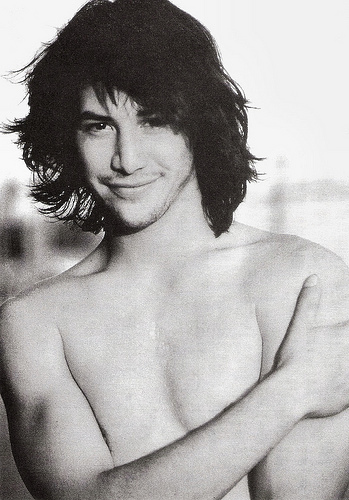
British postcard, no. 1034.
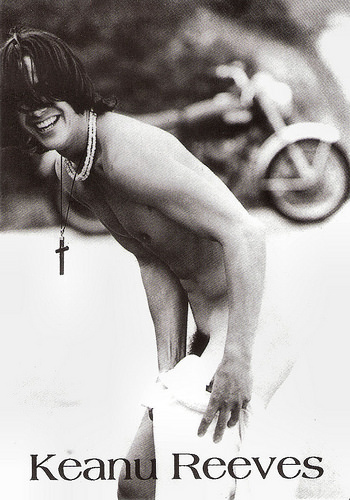
British postcard by Box Office, London, no. BO 007.
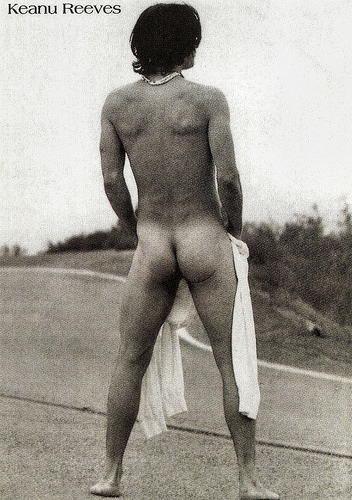
British postcard by Underground, London, no. MM 396.
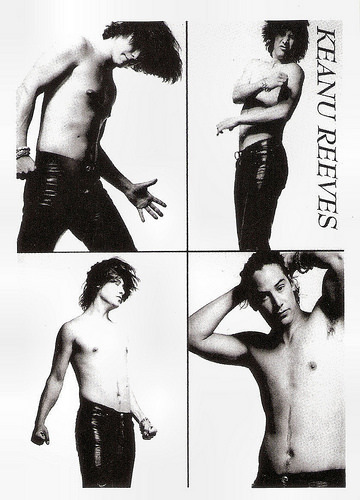
British postcard by Underground, London, no. BO110.
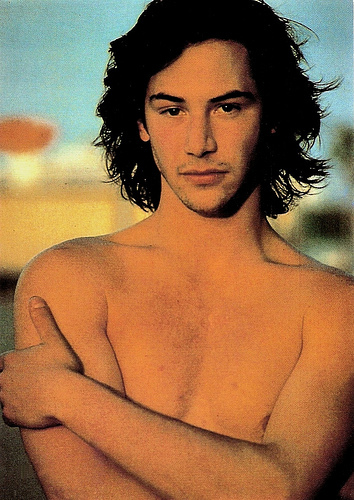
British postcard by Heroes Publishing Ltd., London, no. SPC2621.
Most Desirable Male
In the following years, Keanu Reeves tried to shake the Ted stigma. He developed an eclectic film roster that included high-budget action films like the surf thriller Point Break (Kathryn Bigelow, 1991) for which he won MTV's ‘Most Desirable Male’ award in 1992, but also lower-budget art-house films.
My Own Private Idaho (1991), directed by Gus Van Sant and co-starring River Phoenix, chronicled the lives of two young hustlers living on the streets. In Francis Ford Coppola’s adaptation of Bram Stoker’s Dracula (1992), Reeves embodied the calm resolute lawyer Jonathan Harker who stumbles into the lair of Gary Oldman’s Count Dracula.
In Europe, he played prince Siddharta who becomes the Buddha in Bernardo Bertolucci’s Italian-French-British drama Little Buddha (1993).
His career reached a new high when he starred opposite Sandra Bullock in the hit action film Speed (Jan de Bont, 1994). It was followed by the romantic drama A Walk in the Clouds (Alfonso Arau, 1995) and the supernatural thriller Devil’s Advocate (Taylor Hackford, 1997), co-starring Al Pacino and Charlize Theron.
At the close of the decade, Reeves starred in a Sci-fi film that would become a genre game changer, The Matrix (Andy and Lana Wachowski, 1999). Reeves played the prophetic figure Neo, slated to lead humanity to freedom from an all-consuming simulated world. Known for its innovative fight sequences, avant-garde special effects and gorgeous fashion, The Matrix was an international hit. Two sequels, The Matrix Reloaded (Andy and Lana Wachowski, 1999) and The Matrix Revolutions (Andy and Lana Wachowski, 1999) followed and The Matrix Reloaded was even a bigger financial blockbuster than its predecessor.
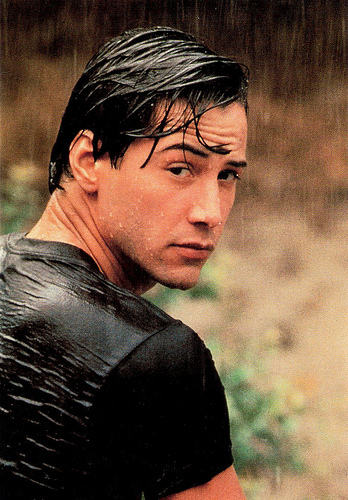
British postcard by Heroes Publishing Ltd., London, no. SPC2581. Photo: publicity still for Point Break (Kathryn Bigelow, 1991).
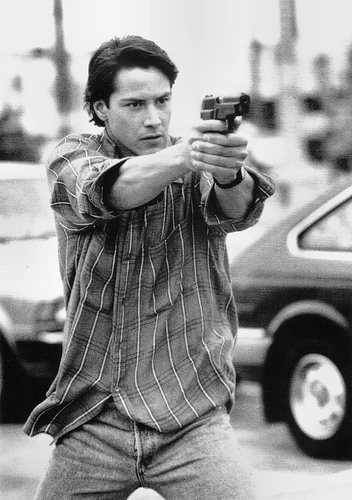
British postcard, no. 1004. Photo: publicity still for Point Break (Kathryn Bigelow, 1991).
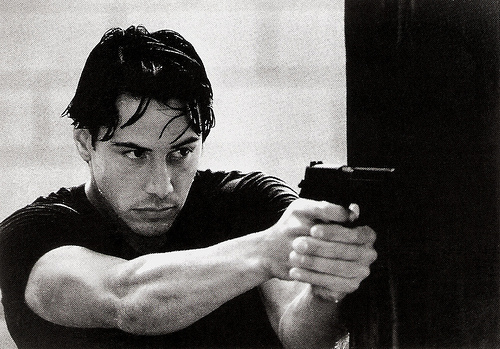
Vintage postcard, no. PP 105. Photo: publicity still for Point Break (Kathryn Bigelow, 1991).
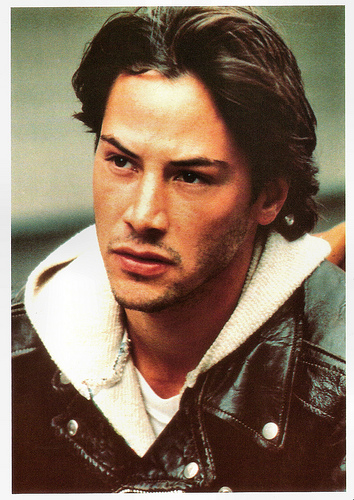
British postcard by Santoro Graphics Ltd., South Yorks, no. C350. Photo: publicity still for My Own Private Idaho (Gus Van Sant, 1991).
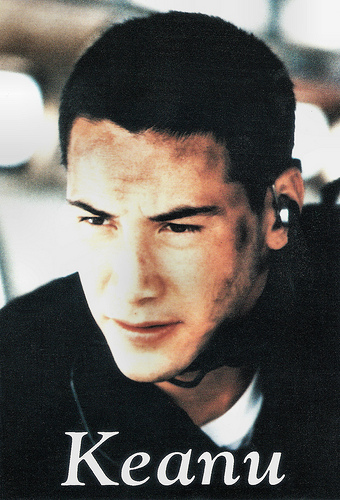
British postcard, no. 2070. Photo: publicity still for Speed (Jan de Bont, 1994).
A major bonafide box office star
Now a major, bonafide box office star, Keanu Reeves continued to work in different genres and both in big-budget as in small independent films. He played an abusive man in the supernatural thriller The Gift (Sam Raimi, 2000), starring Cate Blanchett, a smitten doctor in the romantic comedy Something’s Gotta Give (Nancy Meyers, 2003) opposite Diane Keaton, and a Brit demon hunter in American-German occult detective action film Constantine (Francis Lawrence, 2005).
His appearance in the animated science fiction thriller A Scanner Darkly (Richard Linklater, 2006), based on the novel by Philip K. Dick, received favourable reviews, and The Lake House (Alejandro Agresti, 2006) , his romantic outing with Sandra Bullock, was a success at the box office.
Reeves returned to Sci-fi as alien Klaatu in The Day the Earth Stood Still (Scott Derrickson, 2008), the remake of the 1951 classic. Then he played a supporting part in Rebecca Miller's The Private Life of Pippa Lee (2009), which starred Robin Wright and premiered at the 59th Berlin International Film Festival.
Reeves co-founded a production company, Company Films. The company helped produce Henry's Crime (Malcolm Venville, 2010), in which Reeves also starred. The actor made his directorial debut with the Chinese-American Martial arts film Man of Tai Chi (2013), partly inspired by the life of Reeves' friend, stuntman Tiger Chen. Martial arts–based themes continued in Reeves's next feature, 47 Ronin (Carl Rinsch, 2013), about a real-life group of masterless samurai in 18th-century Japan who avenged the death of their lord. Variety magazine listed 47 Ronin as one of "Hollywood's biggest box office bombs of 2013".
Reeves returned as a retired hitman in the Neo-Noir action thriller John Wick (Chad Stahelski, David Leitch, 2014). The film opened to positive reviews and performed well at the box office. A sequel, titled John Wick: Chapter Two, is currently in production and is scheduled to be released in 2017. This year, he could be seen in the psychological horror film The Neon Demon (Nicolas Winding Refn, 2016) and the romantic horror-thriller Bad Batch (Ana Lily Amirpour, 2016).
Reeves’ artistic aspirations are not limited to film. In the early 1990s, he co-founded the grunge band Dogstar, which released two albums. He later played bass for a band called Becky. Reeves is also a longtime motorcycle enthusiast. After asking designer Gard Hollinger to create a custom-built bike for him, the two went into business together with the formation of Arch Motorcycle Company LLC in 2011.
Reported to be one of the more generous actors in Hollywood, Reeves helped care for his sister during her lengthy battle with leukaemia, and has supported such organisations as Stand Up To Cancer and PETA. In January 2000, Reeves's girlfriend, Jennifer Syme, gave birth eight months into her pregnancy to Ava Archer Syme-Reeves, who was stillborn. The strain put on their relationship by their grief resulted in Reeves and Syme's breakup several weeks later. In 2001, Syme died after a car accident.
Trailer Bill & Ted's Excellent Adventure (1989). Source: Movieclips Trailer Vault (YouTube).
Trailer Point Break (1991). Source: Adam Jackson (YouTube).
Trailer Speed (1994). Source: 4thMealisGood (YouTube).
Trailer Little Buddha (1993). Source: vijay kumar (YouTube).
Trailer John Wick (2014). Source: Movieclips Trailers (YouTube).
Sources: Biography.com, Wikipedia and .

Vintage postcard, no. C 445.

British postcard, no. MM373.

British postcard by Heroes Publishing Ltd., London, no. SPC 3017.

Spanish postcard by Coleccion Estrellas Cinematograficas, Cacitel, no. 73.

British postcard, no. MM371.
Cool breeze over the mountains
Keanu Charles Reeves was born in 1964, in Beirut, Lebanon. His first name means ‘cool breeze over the mountains’ in Hawaiian. His father, Samuel Nowlin Reeves Jr., was a geologist of Chinese-Hawaiian heritage, and his mother, Patricia Bond (née Taylor), was a British showgirl and later a costume designer for rock stars such as Alice Cooper.
Reeves's mother was working in Beirut when she met his father. Upon his parents’ split in 1966, Keanu moved with his mother and younger sister Kim Reeves to Sydney, to New York and then to Toronto. As a child, he lived with various stepfathers, including stage and film director Paul Aaron.
Keanu developed an ardour for hockey, though he would eventually turn to acting. At 15, he played Mercutio in a stage production of Romeo and Juliet at the Leah Posluns Theatre. Reeves dropped out of high school when he was 17.
His film debut was the Canadian feature One Step Away (Robert Fortier, 1985). After a part in the teen movie Youngblood (Peter Markle, 1986), starring Rob Lowe, he obtained a green card through stepfather Paul Aaron and moved to Los Angeles.
After a few minor roles, he gained attention for his performance in the dark drama River's Edge (Tim Hunter, 1986), which depicted how a murder affected a group of adolescents. Reeves landed a supporting role in the Oscar-nominated period drama Dangerous Liaisons (Stephen Frears, 1988), starring Glenn Close and John Malkovich. Reeves joined the casts of Ron Howard's comedy Parenthood (1989), and Lawrence Kasdan's I Love You to Death (1990).
Unexpectedly successful was the wacky comedy Bill & Ted's Excellent Adventure (Stephen Herek, 1989) which followed two high school students (Reeves and Alex Winter) and their time-travelling high jinks. The success lead to a TV series and a sequel, Bill & Ted's Bogus Journey (Pete Hewitt, 1991). From then on, audiences often confused Reeves's real-life persona with that of his doofy on-screen counterpart.

British postcard, no. 1034.

British postcard by Box Office, London, no. BO 007.

British postcard by Underground, London, no. MM 396.

British postcard by Underground, London, no. BO110.

British postcard by Heroes Publishing Ltd., London, no. SPC2621.
Most Desirable Male
In the following years, Keanu Reeves tried to shake the Ted stigma. He developed an eclectic film roster that included high-budget action films like the surf thriller Point Break (Kathryn Bigelow, 1991) for which he won MTV's ‘Most Desirable Male’ award in 1992, but also lower-budget art-house films.
My Own Private Idaho (1991), directed by Gus Van Sant and co-starring River Phoenix, chronicled the lives of two young hustlers living on the streets. In Francis Ford Coppola’s adaptation of Bram Stoker’s Dracula (1992), Reeves embodied the calm resolute lawyer Jonathan Harker who stumbles into the lair of Gary Oldman’s Count Dracula.
In Europe, he played prince Siddharta who becomes the Buddha in Bernardo Bertolucci’s Italian-French-British drama Little Buddha (1993).
His career reached a new high when he starred opposite Sandra Bullock in the hit action film Speed (Jan de Bont, 1994). It was followed by the romantic drama A Walk in the Clouds (Alfonso Arau, 1995) and the supernatural thriller Devil’s Advocate (Taylor Hackford, 1997), co-starring Al Pacino and Charlize Theron.
At the close of the decade, Reeves starred in a Sci-fi film that would become a genre game changer, The Matrix (Andy and Lana Wachowski, 1999). Reeves played the prophetic figure Neo, slated to lead humanity to freedom from an all-consuming simulated world. Known for its innovative fight sequences, avant-garde special effects and gorgeous fashion, The Matrix was an international hit. Two sequels, The Matrix Reloaded (Andy and Lana Wachowski, 1999) and The Matrix Revolutions (Andy and Lana Wachowski, 1999) followed and The Matrix Reloaded was even a bigger financial blockbuster than its predecessor.

British postcard by Heroes Publishing Ltd., London, no. SPC2581. Photo: publicity still for Point Break (Kathryn Bigelow, 1991).

British postcard, no. 1004. Photo: publicity still for Point Break (Kathryn Bigelow, 1991).

Vintage postcard, no. PP 105. Photo: publicity still for Point Break (Kathryn Bigelow, 1991).

British postcard by Santoro Graphics Ltd., South Yorks, no. C350. Photo: publicity still for My Own Private Idaho (Gus Van Sant, 1991).

British postcard, no. 2070. Photo: publicity still for Speed (Jan de Bont, 1994).
A major bonafide box office star
Now a major, bonafide box office star, Keanu Reeves continued to work in different genres and both in big-budget as in small independent films. He played an abusive man in the supernatural thriller The Gift (Sam Raimi, 2000), starring Cate Blanchett, a smitten doctor in the romantic comedy Something’s Gotta Give (Nancy Meyers, 2003) opposite Diane Keaton, and a Brit demon hunter in American-German occult detective action film Constantine (Francis Lawrence, 2005).
His appearance in the animated science fiction thriller A Scanner Darkly (Richard Linklater, 2006), based on the novel by Philip K. Dick, received favourable reviews, and The Lake House (Alejandro Agresti, 2006) , his romantic outing with Sandra Bullock, was a success at the box office.
Reeves returned to Sci-fi as alien Klaatu in The Day the Earth Stood Still (Scott Derrickson, 2008), the remake of the 1951 classic. Then he played a supporting part in Rebecca Miller's The Private Life of Pippa Lee (2009), which starred Robin Wright and premiered at the 59th Berlin International Film Festival.
Reeves co-founded a production company, Company Films. The company helped produce Henry's Crime (Malcolm Venville, 2010), in which Reeves also starred. The actor made his directorial debut with the Chinese-American Martial arts film Man of Tai Chi (2013), partly inspired by the life of Reeves' friend, stuntman Tiger Chen. Martial arts–based themes continued in Reeves's next feature, 47 Ronin (Carl Rinsch, 2013), about a real-life group of masterless samurai in 18th-century Japan who avenged the death of their lord. Variety magazine listed 47 Ronin as one of "Hollywood's biggest box office bombs of 2013".
Reeves returned as a retired hitman in the Neo-Noir action thriller John Wick (Chad Stahelski, David Leitch, 2014). The film opened to positive reviews and performed well at the box office. A sequel, titled John Wick: Chapter Two, is currently in production and is scheduled to be released in 2017. This year, he could be seen in the psychological horror film The Neon Demon (Nicolas Winding Refn, 2016) and the romantic horror-thriller Bad Batch (Ana Lily Amirpour, 2016).
Reeves’ artistic aspirations are not limited to film. In the early 1990s, he co-founded the grunge band Dogstar, which released two albums. He later played bass for a band called Becky. Reeves is also a longtime motorcycle enthusiast. After asking designer Gard Hollinger to create a custom-built bike for him, the two went into business together with the formation of Arch Motorcycle Company LLC in 2011.
Reported to be one of the more generous actors in Hollywood, Reeves helped care for his sister during her lengthy battle with leukaemia, and has supported such organisations as Stand Up To Cancer and PETA. In January 2000, Reeves's girlfriend, Jennifer Syme, gave birth eight months into her pregnancy to Ava Archer Syme-Reeves, who was stillborn. The strain put on their relationship by their grief resulted in Reeves and Syme's breakup several weeks later. In 2001, Syme died after a car accident.
Trailer Bill & Ted's Excellent Adventure (1989). Source: Movieclips Trailer Vault (YouTube).
Trailer Point Break (1991). Source: Adam Jackson (YouTube).
Trailer Speed (1994). Source: 4thMealisGood (YouTube).
Trailer Little Buddha (1993). Source: vijay kumar (YouTube).
Trailer John Wick (2014). Source: Movieclips Trailers (YouTube).
Sources: Biography.com, Wikipedia and .
Published on December 16, 2016 22:00
December 15, 2016
EFSP's Dazzling Dozen: Rediscovering the Operetta
As a kid, I hated, hated, hated operettas. Our family had a subscription to all the operettas that were performed in the Philips Entertainment Centre (a theatre in my hometown Eindhoven, the city of the Philips factories). I remember especially the lady with too much hair and too much perfume sitting before me. Because of her high style I couldn't see anything and the sweet perfume obstructed to bend forward to peak around her. So for me no Fledermaus nor Bettelstudent. And that never changed, until I discovered these witty and charming postcards of the operettas of the early sound films (and of the silent area!). So, can all these operetta fans have been wrong? Don't know, let's waltz!

German postcard by Ross Verlag, no. 48/1. Mady Christians and Willy Fritsch in the Ufa-film Ein Walzertraum (Ludwig Berger, 1925).

German postcard by Ross Verlag, no. 56/3, 1925-1926. Photo: Zelnik Film. Publicity still for An der schönen blauen Donau/The Beautiful Blue Danube (Friedrich Zelnik, 1926) with Lya Mara . Collection: Geoffrey Donaldson Institute.

German postcard by Ross Verlag, no. 91/2. Photo: Aafa. Publicity still for the silent Der Bettelstudent/The Beggar Student (Jacob & Luise Fleck, 1927) with Maria Paudler and Agnes Esterhazy .

German postcard by Ross Verlag, no. 82/1. Photo: Defu. Publicity still of Lya Mara in Das tanzende Wien/Dancing Vienna (Friedrich Zelnik, 1927).
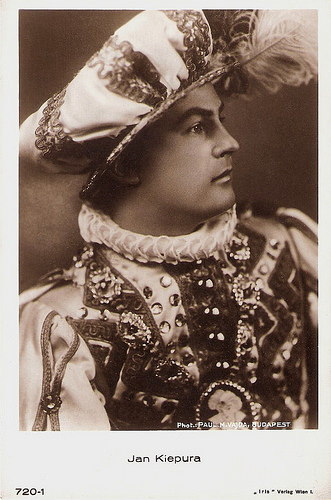
Austrian postcard by Iris-Verlag, Wien, no. 720-1. Photo: Paul M. Vajda, Budapest. Polish actor and singer Jan Kiepura (1902-1966) was one of the grand tenors of the 20th century and with his handsome smile he also became a popular film star. Solo and together with Marta Eggerth he starred in many popular film operettas of the 1930s.

German postcard by Ross Verlag, no. 5384/1, 1930-1931. Photo: AAFA Film. Publicity still for Leutnant warst Du einst bei deinen Husaren/Lieutenant were you once with your Hussar (Manfred Noa, 1930) with Mady Christians .

German postcard by Ross Verlag, no. 6095/1, 1931-1932. Photo: Ufa. Lilian Harvey was Ufa's biggest star of the 1930s. With Willy Fritsch she formed the 'Dream Team of the European Cinema'. Their best film was the immensely popular film operetta Der Kongress tanzt/The Congress Dances (Erik Charell, 1931).

German postcard by Ross Verlag, no. 131/8. Photo: Ufa. Still from Der Kongress Tanzt/The Congress Dances (Erik Charell, 1931) with Paul Hörbiger. Der Kongress Tanzt is a sensual, made with great fun, original, capricious and extravagant operetta. It has elegance, a great cast, brilliant music and songs, wit, great sets; some scenes are even a bit bizarre and fetishistic. This is not a filmed operetta, but a real film-operetta.

German postcard by Ross Verlag, no. 152/3 Photo: Ufa. Publicity still for Der Schwarze Husar/The Black Hussar (Gerhard Lamprecht, 1932) with Otto Wallburg and Mady Christians . Otto Wallburg appeared in supporting roles as the overweight comedian. After the rise of the Nazis the Jewish actor had to go in exile, first in Austria and later in the Netherlands. He was murdered by the Nazis in Auschwitz concentration camp.

German postcard by Ross Verlag, no. 192/2, 1932-1933. Photo: Ufa. Publicity still for Walzerkrieg/Waltz Time in Vienna (Ludwig Berger, 1933) with Willy Fritsch . Collection: Geoffrey Donaldson Institute.

German postcard by Ross Verlag, no. 192/4. Photo: Ufa. Publicity still for Walzerkrieg (Ludwig Berger, 1933) with Rose Barsony and Willy Fritsch . Hungarian Rose Barsony appeared in 16 films from 1929 to 1938, and was a popular star of the operettas by Paul Abraham.

Dutch postcard by Filma, no. 450. Photo: publicity still for Die Blume von Hawaï/The Flower of Hawaii (Richard Oswald, 1933), an adaptation of the operetta The Flower of Hawaii by Paul Abraham. Star was Marta Eggerth .
This is the last post in EFSP's Dazzling Dozen series, for now.
It is Postcard Friendship Friday, hosted by Beth at the The Best Hearts are Crunchy. You can visit her by clicking on the button below.


German postcard by Ross Verlag, no. 48/1. Mady Christians and Willy Fritsch in the Ufa-film Ein Walzertraum (Ludwig Berger, 1925).

German postcard by Ross Verlag, no. 56/3, 1925-1926. Photo: Zelnik Film. Publicity still for An der schönen blauen Donau/The Beautiful Blue Danube (Friedrich Zelnik, 1926) with Lya Mara . Collection: Geoffrey Donaldson Institute.

German postcard by Ross Verlag, no. 91/2. Photo: Aafa. Publicity still for the silent Der Bettelstudent/The Beggar Student (Jacob & Luise Fleck, 1927) with Maria Paudler and Agnes Esterhazy .

German postcard by Ross Verlag, no. 82/1. Photo: Defu. Publicity still of Lya Mara in Das tanzende Wien/Dancing Vienna (Friedrich Zelnik, 1927).

Austrian postcard by Iris-Verlag, Wien, no. 720-1. Photo: Paul M. Vajda, Budapest. Polish actor and singer Jan Kiepura (1902-1966) was one of the grand tenors of the 20th century and with his handsome smile he also became a popular film star. Solo and together with Marta Eggerth he starred in many popular film operettas of the 1930s.

German postcard by Ross Verlag, no. 5384/1, 1930-1931. Photo: AAFA Film. Publicity still for Leutnant warst Du einst bei deinen Husaren/Lieutenant were you once with your Hussar (Manfred Noa, 1930) with Mady Christians .

German postcard by Ross Verlag, no. 6095/1, 1931-1932. Photo: Ufa. Lilian Harvey was Ufa's biggest star of the 1930s. With Willy Fritsch she formed the 'Dream Team of the European Cinema'. Their best film was the immensely popular film operetta Der Kongress tanzt/The Congress Dances (Erik Charell, 1931).

German postcard by Ross Verlag, no. 131/8. Photo: Ufa. Still from Der Kongress Tanzt/The Congress Dances (Erik Charell, 1931) with Paul Hörbiger. Der Kongress Tanzt is a sensual, made with great fun, original, capricious and extravagant operetta. It has elegance, a great cast, brilliant music and songs, wit, great sets; some scenes are even a bit bizarre and fetishistic. This is not a filmed operetta, but a real film-operetta.

German postcard by Ross Verlag, no. 152/3 Photo: Ufa. Publicity still for Der Schwarze Husar/The Black Hussar (Gerhard Lamprecht, 1932) with Otto Wallburg and Mady Christians . Otto Wallburg appeared in supporting roles as the overweight comedian. After the rise of the Nazis the Jewish actor had to go in exile, first in Austria and later in the Netherlands. He was murdered by the Nazis in Auschwitz concentration camp.

German postcard by Ross Verlag, no. 192/2, 1932-1933. Photo: Ufa. Publicity still for Walzerkrieg/Waltz Time in Vienna (Ludwig Berger, 1933) with Willy Fritsch . Collection: Geoffrey Donaldson Institute.

German postcard by Ross Verlag, no. 192/4. Photo: Ufa. Publicity still for Walzerkrieg (Ludwig Berger, 1933) with Rose Barsony and Willy Fritsch . Hungarian Rose Barsony appeared in 16 films from 1929 to 1938, and was a popular star of the operettas by Paul Abraham.

Dutch postcard by Filma, no. 450. Photo: publicity still for Die Blume von Hawaï/The Flower of Hawaii (Richard Oswald, 1933), an adaptation of the operetta The Flower of Hawaii by Paul Abraham. Star was Marta Eggerth .
This is the last post in EFSP's Dazzling Dozen series, for now.
It is Postcard Friendship Friday, hosted by Beth at the The Best Hearts are Crunchy. You can visit her by clicking on the button below.

Published on December 15, 2016 22:00
December 14, 2016
Flora Robson
British Flora Robson (1902-1984) was one of the half dozen finest dramatic actresses of her generation. Her range extended from queens to murderesses and she was particularly renowned for her performances in plays demanding dramatic and emotional intensity. Her best known film role was that of Queen Elizabeth I in both Fire Over England (1937) and The Sea Hawk (1940). However, her career was a constant struggle to achieve the roles worthy of her talents.

British postcard by Art Photo Postcard, no. 109. Photo: London Films. Publicity still for Fire Over England (William K. Howard, 1937).
Taken around by horse and carriage to recite
Flora McKenzie Robson was born in South Shields, County Durham. She was of Scottish descent to a family of six siblings. Her father was a ship's engineer. He discovered that Flora had a talent for recitation and she recited Little Orphan Annie in a school performance.
From the age of five, she was taken around by horse and carriage to recite, and to compete in recitations. She was educated at the Palmers Green High School and the Royal Academy of Dramatic Art (RADA).
At 19, Robson made her stage debut as Queen Margret in the play Wil Shakespeare in 1921. She graduated from RADA with a bronze medal, but then she struggled to find a footing in the theatre. She had a long face with a big nose and a wide mouth and apparently lacked the looks which were then an absolute requisite for actresses in dramatic roles.
After touring in minor parts with Ben Greet's Shakespeare company she played small parts for two seasons in the new repertory company at Oxford, alongside a youthful John Gielgud . Then her contract was not renewed.
Wikipedia : “she was told, as tactfully as possible, that they required a prettier actress. Unable to secure any acting engagements she gave up the stage at the age of 23 and in a disconsolate life-change she took up work as a welfare officer in the Shredded Wheat factory in Welwyn Garden City”.
In the factory, she formed an amateur theatrical group among the workers there. She later credited this experience with enlarging her view of dramatic structure and acting. In 1929, Tyrone Guthrie, due to direct a season at the new Festival Theatre, Cambridge, asked her to join his company. It was the dramatic making of her.
She played the stepdaughter in Pirandello's Six Characters in Search of an author and her acting made her the theatrical talk of Cambridge. More excited applause followed with her Isabella in Measure for Measure, opposite a youthful Robert Donat , the title role in Iphigenia, Varya in the Cherry Orchard and finally the huge challenge of Rebecca West in Ibsen's Rosmersholm.
These performances signalled the arrival of an actress who could either transmit emotional stress or simply hint at it, with rare power. In her second season, though, she had few dramatic opportunities and once again her lack of chocolate-box appeal meant that the management dispensed with her services.

British postcard in the Picturegoer Series, London, no. 901. Photo: Janet Jevons.
Caught in the theatrical firmament as a star
In the early 1930s, Flora Robson was cast as the adulterous Abbie in Eugene O'Neill's Desire under the Elms. At the time, the censors considered the play as too shocking to be given a public performance. In the little club theatre, The Gate, near Robson scored a direct hit with audiences and critics alike.
Then, her brief, shocking appearance as the doomed prostitute in James Bridie's play The Anatomist was another success. This lead to a season as leading lady at the Old Vic, opposite Charles Laughton . By the end of 1933 she was caught in the theatrical firmament as a star.
Cinema beckoned. Her film debut had been a bit part in A Gentleman of Paris (Sinclair Hill, 1931). In 1934, Robson played the Russian Empress Elizabeth in Catherine the Great (Paul Czinner, 1934). The historical film was produced by Alexander Korda and based on the play The Czarina by Lajos Bíró and Melchior Lengyel, about the rise to power of Catherine the Great. Elisabeth Bergner starred as Catherine.
Robson played a forceful Livia in another Korda production I, Claudius (Josef von Sternberg,1937). This was an unfinished film adaptation of the novels I, Claudius (1934) and Claudius the God (1935) by Robert Graves. Charles Laughton played the title role, but the production was dogged by adverse circumstances, culminating in a car accident involving co-star Merle Oberon that caused filming to be ended before completion.
Robson’s best known film role was that of Queen Elizabeth I in both Fire Over England (William K. Howard, 1937) starring Laurence Olivier and Vivien Leigh , and the Hollywood Swashbuckler The Sea Hawk (Michael Curtiz, 1940) starring Errol Flynn.
She was nominated for the Academy Award for Best Supporting Actress for her role as Ingrid Bergman 's Haitian maid, Angelique Buiton in the romantic drama Saratoga Trunk (Sam Wood, 1945). That same year she gave a hypnotic performance as Ftatateeta, the nursemaid and royal confidante to Vivien Leigh 's Queen Cleopatra in the screen adaptation of George Bernard Shaw's Caesar and Cleopatra (Gabriel Pascal, 1945). On stage, she was acclaimed in 1942 in the John Van Druten play The Damask Cheek, and in 1949 as the unhappy mother in Leslie Storm's Black Chiffon.

British postcard in the Film Star Autograph Portrait Series, no. 65, by L.D. Ltd., London. Photo: J. Arthur Rank Organisation.

British autograph card by J. Hamilton Mews, London.
Very little personal love
After the Second World War, Flora Robson demonstrated her range again in the cinema. She first appeared in the comedy Holiday Camp (Ken Annakin, 1947), the first of a series of films which featured the very ordinary Huggett family. That same year, she appeared as Sister Philippa in Black Narcissus (Michael Powell, Emeric Pressburger, 1947), she was a magistrate in Goodtime Girl (David MacDonald, 1948), and a prospective Labour MP in Frieda (Basil Dearden, 1947) featuring Mai Zetterling .
She also appeared in the costume melodrama, Saraband for Dead Lovers (Basil Dearden, 1948), starring Stewart Granger . On stage followed memorable theatrical performances as Lady Macbeth on Broadway (1949) and as Paulina in Shakespeare's The Winter's Tale (1951) production by John Gielgud .
She was created a Commander of the Order of the British Empire (CBE) in 1952, and raised to Dame Commander (DBE) in 1960. In between she appeared in such films as Romeo and Juliet (Renato Castellani, 1954) as Juliet’s nurse, and the drama High Tide at Noon (Philip Leacock, 1957).
In the 1960s she continued to act in the West End, in such plays as Ring Round the Moon, The Importance of Being Earnest and Three Sisters. Her later film roles include the Empress Dowager Cixi in the historical epic 55 Days at Peking (Nicholas Ray, 1963), Miss Milchrest in the Miss Marple mystery Murder at the Gallop (George Pollock, 1963), and the Queen of Hearts in Alice's Adventures in Wonderland (William Sterling, 1972).
She continued her acting career late into life, though not on the West End stage, from which she retired at the age of 67. She often played in American television films, including a lavish production of A Tale of Two Cities. She also performed in films for British television, including The Shrimp and the Anemone.
In the cinema, she was last briefly seen a Stygian Witch in the fantasy adventure Clash of the Titans (Desmond Davis, 1981) starring Harry Hamlin. Both the BBC and ITV made special programmes to celebrate her 80th birthday in 1982 and the BBC ran a short season of her best films.
Her private life was largely focused on her large family of sisters, nephews and nieces, who used the home in Wykeham Terrace, Brighton, which she shared with sisters, Margaret and Shela. In 1984, Flora Robson died in the English seaside resort of Brighton. She was 82. She never married or had any children.
"I've known very little personal love, but the public has always shown me great affection", Dame Flora was once quoted. Her two sisters, with whom she shared her life and home, died around the same time.
Trailer The Sea Hawk (1940). Source: retrotrailer (YouTube).
Trailer Black Narcissus (1947). Source: ryy79 (YouTube).
Trailer Beast In The Cellar (1970). Source: Screenbound Pictures (YouTube).
Sources: (IMDb), Marvine Howe (The New York Times), Encyclopaedia Britannica, Wikipedia and .

British postcard by Art Photo Postcard, no. 109. Photo: London Films. Publicity still for Fire Over England (William K. Howard, 1937).
Taken around by horse and carriage to recite
Flora McKenzie Robson was born in South Shields, County Durham. She was of Scottish descent to a family of six siblings. Her father was a ship's engineer. He discovered that Flora had a talent for recitation and she recited Little Orphan Annie in a school performance.
From the age of five, she was taken around by horse and carriage to recite, and to compete in recitations. She was educated at the Palmers Green High School and the Royal Academy of Dramatic Art (RADA).
At 19, Robson made her stage debut as Queen Margret in the play Wil Shakespeare in 1921. She graduated from RADA with a bronze medal, but then she struggled to find a footing in the theatre. She had a long face with a big nose and a wide mouth and apparently lacked the looks which were then an absolute requisite for actresses in dramatic roles.
After touring in minor parts with Ben Greet's Shakespeare company she played small parts for two seasons in the new repertory company at Oxford, alongside a youthful John Gielgud . Then her contract was not renewed.
Wikipedia : “she was told, as tactfully as possible, that they required a prettier actress. Unable to secure any acting engagements she gave up the stage at the age of 23 and in a disconsolate life-change she took up work as a welfare officer in the Shredded Wheat factory in Welwyn Garden City”.
In the factory, she formed an amateur theatrical group among the workers there. She later credited this experience with enlarging her view of dramatic structure and acting. In 1929, Tyrone Guthrie, due to direct a season at the new Festival Theatre, Cambridge, asked her to join his company. It was the dramatic making of her.
She played the stepdaughter in Pirandello's Six Characters in Search of an author and her acting made her the theatrical talk of Cambridge. More excited applause followed with her Isabella in Measure for Measure, opposite a youthful Robert Donat , the title role in Iphigenia, Varya in the Cherry Orchard and finally the huge challenge of Rebecca West in Ibsen's Rosmersholm.
These performances signalled the arrival of an actress who could either transmit emotional stress or simply hint at it, with rare power. In her second season, though, she had few dramatic opportunities and once again her lack of chocolate-box appeal meant that the management dispensed with her services.

British postcard in the Picturegoer Series, London, no. 901. Photo: Janet Jevons.
Caught in the theatrical firmament as a star
In the early 1930s, Flora Robson was cast as the adulterous Abbie in Eugene O'Neill's Desire under the Elms. At the time, the censors considered the play as too shocking to be given a public performance. In the little club theatre, The Gate, near Robson scored a direct hit with audiences and critics alike.
Then, her brief, shocking appearance as the doomed prostitute in James Bridie's play The Anatomist was another success. This lead to a season as leading lady at the Old Vic, opposite Charles Laughton . By the end of 1933 she was caught in the theatrical firmament as a star.
Cinema beckoned. Her film debut had been a bit part in A Gentleman of Paris (Sinclair Hill, 1931). In 1934, Robson played the Russian Empress Elizabeth in Catherine the Great (Paul Czinner, 1934). The historical film was produced by Alexander Korda and based on the play The Czarina by Lajos Bíró and Melchior Lengyel, about the rise to power of Catherine the Great. Elisabeth Bergner starred as Catherine.
Robson played a forceful Livia in another Korda production I, Claudius (Josef von Sternberg,1937). This was an unfinished film adaptation of the novels I, Claudius (1934) and Claudius the God (1935) by Robert Graves. Charles Laughton played the title role, but the production was dogged by adverse circumstances, culminating in a car accident involving co-star Merle Oberon that caused filming to be ended before completion.
Robson’s best known film role was that of Queen Elizabeth I in both Fire Over England (William K. Howard, 1937) starring Laurence Olivier and Vivien Leigh , and the Hollywood Swashbuckler The Sea Hawk (Michael Curtiz, 1940) starring Errol Flynn.
She was nominated for the Academy Award for Best Supporting Actress for her role as Ingrid Bergman 's Haitian maid, Angelique Buiton in the romantic drama Saratoga Trunk (Sam Wood, 1945). That same year she gave a hypnotic performance as Ftatateeta, the nursemaid and royal confidante to Vivien Leigh 's Queen Cleopatra in the screen adaptation of George Bernard Shaw's Caesar and Cleopatra (Gabriel Pascal, 1945). On stage, she was acclaimed in 1942 in the John Van Druten play The Damask Cheek, and in 1949 as the unhappy mother in Leslie Storm's Black Chiffon.

British postcard in the Film Star Autograph Portrait Series, no. 65, by L.D. Ltd., London. Photo: J. Arthur Rank Organisation.

British autograph card by J. Hamilton Mews, London.
Very little personal love
After the Second World War, Flora Robson demonstrated her range again in the cinema. She first appeared in the comedy Holiday Camp (Ken Annakin, 1947), the first of a series of films which featured the very ordinary Huggett family. That same year, she appeared as Sister Philippa in Black Narcissus (Michael Powell, Emeric Pressburger, 1947), she was a magistrate in Goodtime Girl (David MacDonald, 1948), and a prospective Labour MP in Frieda (Basil Dearden, 1947) featuring Mai Zetterling .
She also appeared in the costume melodrama, Saraband for Dead Lovers (Basil Dearden, 1948), starring Stewart Granger . On stage followed memorable theatrical performances as Lady Macbeth on Broadway (1949) and as Paulina in Shakespeare's The Winter's Tale (1951) production by John Gielgud .
She was created a Commander of the Order of the British Empire (CBE) in 1952, and raised to Dame Commander (DBE) in 1960. In between she appeared in such films as Romeo and Juliet (Renato Castellani, 1954) as Juliet’s nurse, and the drama High Tide at Noon (Philip Leacock, 1957).
In the 1960s she continued to act in the West End, in such plays as Ring Round the Moon, The Importance of Being Earnest and Three Sisters. Her later film roles include the Empress Dowager Cixi in the historical epic 55 Days at Peking (Nicholas Ray, 1963), Miss Milchrest in the Miss Marple mystery Murder at the Gallop (George Pollock, 1963), and the Queen of Hearts in Alice's Adventures in Wonderland (William Sterling, 1972).
She continued her acting career late into life, though not on the West End stage, from which she retired at the age of 67. She often played in American television films, including a lavish production of A Tale of Two Cities. She also performed in films for British television, including The Shrimp and the Anemone.
In the cinema, she was last briefly seen a Stygian Witch in the fantasy adventure Clash of the Titans (Desmond Davis, 1981) starring Harry Hamlin. Both the BBC and ITV made special programmes to celebrate her 80th birthday in 1982 and the BBC ran a short season of her best films.
Her private life was largely focused on her large family of sisters, nephews and nieces, who used the home in Wykeham Terrace, Brighton, which she shared with sisters, Margaret and Shela. In 1984, Flora Robson died in the English seaside resort of Brighton. She was 82. She never married or had any children.
"I've known very little personal love, but the public has always shown me great affection", Dame Flora was once quoted. Her two sisters, with whom she shared her life and home, died around the same time.
Trailer The Sea Hawk (1940). Source: retrotrailer (YouTube).
Trailer Black Narcissus (1947). Source: ryy79 (YouTube).
Trailer Beast In The Cellar (1970). Source: Screenbound Pictures (YouTube).
Sources: (IMDb), Marvine Howe (The New York Times), Encyclopaedia Britannica, Wikipedia and .
Published on December 14, 2016 22:00
December 13, 2016
Jungle Book (1942)
Young British-Indian actor Sabu had 'a smile as broad as the Ganges and charm enough to lure the stripes off a tiger'. He became an instant star with Elephant Boy in 1937. Another tropical Technicolor treat was the fun and adventurous Jungle Book (Zoltan Korda, 1942), which delighted audiences with Rudyard Kipling's tale of jungle boy Mowgli years before Walt Disney would make its animation classic.
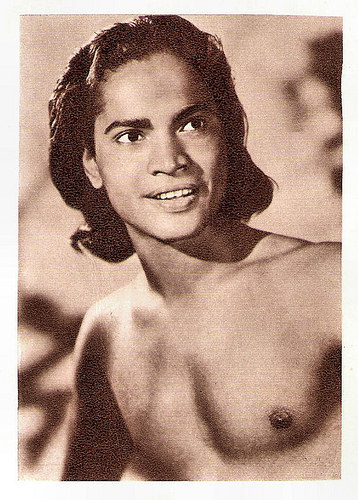
Vintage collectors card. Photo: publicity still for Jungle Book (Zoltan Korda, 1942) with Sabu as Mowgli.

Dutch postcard, no. 850. Photo: Universal Film. Photo: publicity still for Jungle Book (Zoltan Korda, 1942) with Sabu as Mowgli.
Kipling would have been proud
Jungle Book (1942) is a splendid Technicolor production, produced by Sir Alexander Korda and directed by his brother, Zoltan Korda. It is based on Rudyard Kipling's two Jungle Book anthologies (published in 1894 and 1895), which comprise fifteen stories. For the film four of these stories were used: Mowgli's Brothers, How Fear Came, Tiger! Tiger!, and The King's Ankus.
Sabu stars as the teenaged Mowgli, who was raised by wolves in the jungle of India. After he has left his animal friends, Mowgli appears in a village and is adopted by Messua (Rosemary DeCamp). The story of Disney's animation classic, The Jungle Book (Wolfgang Reitherman, 1967), can be seen as a prequel to the story of this film.
In the village, Mowgli learns human language and some human ways quickly, but he keeps his jungle ideas. The animals of the jungle know and respect him, they willingly do as he wishes because, they know that he is good and one of them. The influential merchant Buldeo (Spanish born actor Joseph Calleia) is bigoted against 'beasts' including Mowgli, but not so Buldeo's pretty daughter Mahala (Patricia O'Rourke). Mowgli takes the girl on a jungle tour where they find a treasure. This sets the evil of human greed in motion...
Sabu 's likable and athletic lead role, the lavish sets by Vincent Korda (yet another Korda brother), the exotic and oriental musical score by Miklos Rozsa and the splendid Technicolor cinematography by Lee Garmes and W. Howard Greene of enchanting forests and a lost city make Jungle Book truly amazing for its time.
Ron Oliver at IMDb : "As teen-aged Mowgli, Indian actor Sabu couldn't be more perfect. Whether as the Wild Boy who first enters the village, or, later, as the completely competent young man who ferrets out the secret of the Lost City's treasure, fights the tiger Shere Khan and communes with deadly snakes, elephants & wolves, he is completely believable. Kipling would have been proud."

German collectors card by Küno's Film-Foto in the series Das Dschungelbuch , no. 1, presented by Sparkasse bank. Photo: publicity still for Jungle Book (Zoltan Korda, 1942) with Sabu as Mowgli.

German collectors card by Küno's Film-Foto in the series Das Dschungelbuch , no. 2, presented by Sparkasse bank. Photo: publicity still for Jungle Book (Zoltan Korda, 1942) with Sabu as Mowgli with Wolf.

German collectors card by Küno's Film-Foto in the series Das Dschungelbuch , no. 3, presented by Sparkasse bank. Photo: publicity still for Jungle Book (Zoltan Korda, 1942) with Sabu as Mowgli with Wolf and Panther. Two scenes with the black panther were obviously shot with the panther behind a glass screen, as a safeguard to protect the actors. In both scenes, showing close-ups of the panther, debris is seen adhering to the glass.

German collectors card by Küno's Film-Foto in the series Das Dschungelbuch no. 4, presented by Sparkasse bank. Photo: publicity still for Jungle Book (Zoltan Korda, 1942) with Sabu as Mowgli and the defeated Shere Khan.
Sources: Ron Oliver (IMDb) and IMDb.

Vintage collectors card. Photo: publicity still for Jungle Book (Zoltan Korda, 1942) with Sabu as Mowgli.

Dutch postcard, no. 850. Photo: Universal Film. Photo: publicity still for Jungle Book (Zoltan Korda, 1942) with Sabu as Mowgli.
Kipling would have been proud
Jungle Book (1942) is a splendid Technicolor production, produced by Sir Alexander Korda and directed by his brother, Zoltan Korda. It is based on Rudyard Kipling's two Jungle Book anthologies (published in 1894 and 1895), which comprise fifteen stories. For the film four of these stories were used: Mowgli's Brothers, How Fear Came, Tiger! Tiger!, and The King's Ankus.
Sabu stars as the teenaged Mowgli, who was raised by wolves in the jungle of India. After he has left his animal friends, Mowgli appears in a village and is adopted by Messua (Rosemary DeCamp). The story of Disney's animation classic, The Jungle Book (Wolfgang Reitherman, 1967), can be seen as a prequel to the story of this film.
In the village, Mowgli learns human language and some human ways quickly, but he keeps his jungle ideas. The animals of the jungle know and respect him, they willingly do as he wishes because, they know that he is good and one of them. The influential merchant Buldeo (Spanish born actor Joseph Calleia) is bigoted against 'beasts' including Mowgli, but not so Buldeo's pretty daughter Mahala (Patricia O'Rourke). Mowgli takes the girl on a jungle tour where they find a treasure. This sets the evil of human greed in motion...
Sabu 's likable and athletic lead role, the lavish sets by Vincent Korda (yet another Korda brother), the exotic and oriental musical score by Miklos Rozsa and the splendid Technicolor cinematography by Lee Garmes and W. Howard Greene of enchanting forests and a lost city make Jungle Book truly amazing for its time.
Ron Oliver at IMDb : "As teen-aged Mowgli, Indian actor Sabu couldn't be more perfect. Whether as the Wild Boy who first enters the village, or, later, as the completely competent young man who ferrets out the secret of the Lost City's treasure, fights the tiger Shere Khan and communes with deadly snakes, elephants & wolves, he is completely believable. Kipling would have been proud."

German collectors card by Küno's Film-Foto in the series Das Dschungelbuch , no. 1, presented by Sparkasse bank. Photo: publicity still for Jungle Book (Zoltan Korda, 1942) with Sabu as Mowgli.

German collectors card by Küno's Film-Foto in the series Das Dschungelbuch , no. 2, presented by Sparkasse bank. Photo: publicity still for Jungle Book (Zoltan Korda, 1942) with Sabu as Mowgli with Wolf.

German collectors card by Küno's Film-Foto in the series Das Dschungelbuch , no. 3, presented by Sparkasse bank. Photo: publicity still for Jungle Book (Zoltan Korda, 1942) with Sabu as Mowgli with Wolf and Panther. Two scenes with the black panther were obviously shot with the panther behind a glass screen, as a safeguard to protect the actors. In both scenes, showing close-ups of the panther, debris is seen adhering to the glass.

German collectors card by Küno's Film-Foto in the series Das Dschungelbuch no. 4, presented by Sparkasse bank. Photo: publicity still for Jungle Book (Zoltan Korda, 1942) with Sabu as Mowgli and the defeated Shere Khan.
Sources: Ron Oliver (IMDb) and IMDb.
Published on December 13, 2016 22:00
December 12, 2016
Roberto Benzi
French-Italian pianist and conductor Roberto Benzi (1937) who began his career as a musical whiz kid. He conducted his first concert when he was only six years. In the early 1950s he starred in two popular films by Georges Lecombe.
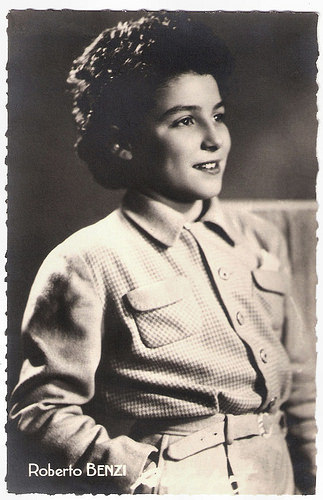
French postcard. Photo: Rotophoto (?).
Musical whiz kid
Roberto Benzi was born of Italian parents in Marseille, France, in 1937. There his father taught solfege. Roberto's musical gifts, in particular his ‘perfect pitch, were apparent from an extremely young age.
At three years old he began to learn solfege and at four, the piano. He conducted his first concert when he was only six years old. A year later, his parents decided to move to Paris to allow their child the best musical education as possible. Roberto then studied orchestral conducting with André Cluytens and in 1948, the only 11-years-old boy started to work as a orchestra conductor.
The musical whiz kid also appeared in two films during the early 1950s. He had a starring role in Prélude à la gloire/Prelude to Glory (Georges Lacombe, 1949). The film pretended not to be a biography of Benzi, who was named Roberto Luigi in the film. Luigi is a street kid and not a music teacher's son, like Benzi. Luigi is a complete autodidact who meets an old conductor, while Benzi had a musical training since he was 3.
D.B. DuMonteil at IMDb : “Georges Lacombe's film is interesting, enhanced by Claude Renoir's camera work. All that Roberto has to do is act naturally because he plays his own role, even if the story is different. No ham acting, but spontaneity and mainly a phenomenal talent: it is something to see this little boy conducting musicians some of whom could be his grandfather! The raison d'être of the film is the last fifteen minutes when Roberto, after refusing to become a performing animal, conducts a Liszt piece.”
Prélude à la gloire was awarded at the Cannes Film Festival in 1950. The film was followed by L'Appel du destin/Call of Destiny (Georges Lacombe, 1953), in which Benzi costarred with Jean Marais . These films enjoyed an immense success throughout Europe, and inspired several young people to embark upon musical careers.
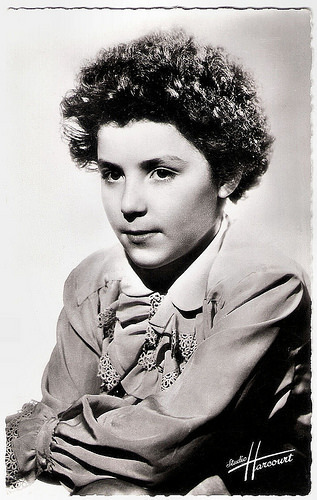
French postcard by Editions du Globe, Paris, no. 157. Photo: Studio Harcourt, Paris.
Knight in the Order of Orange-Nassau
When Roberto Benzi was fourteen, he went to study at the College of Françonville, near Paris.
In 1959 he conducted with great success the opera Carmen by Georges Bizet at the Paris Opera. Since that time he has been engaged at a great number of opera houses.
At 22, he made is first recording and since then he has recorded numerous works for the Philips label. He was guest conductor of many famous European orchestras, such as the Orchestre National de France, the London Philharmonic Orchestra and the Concertgebouw Orchestra of Amsterdam.
Benzi was the founder and resident conductor of the Orchestre de Bordeaux-Aquitaine from 1972 to 1987. In the Netherlands, he was musical and artistic director of the Arnhem Philharmonic Orchestra (Het Gelders Orkest) from 1989 to 1998, and artistic supervisor and conductor of the National Youth Orchestra (NJO) from 1991 to 1995.
He was married to French mezzo soprano Jane Rhodes who passed away in 2011. Roberto Benzi is a Chevalier (Knight) of the Légion d’honneur, the Ordre National du Mérite, the Palmes Académiques and in the Netherlands, Ridder in de Orde van Oranje-Nassau (Knight in the Order of Orange-Nassau).
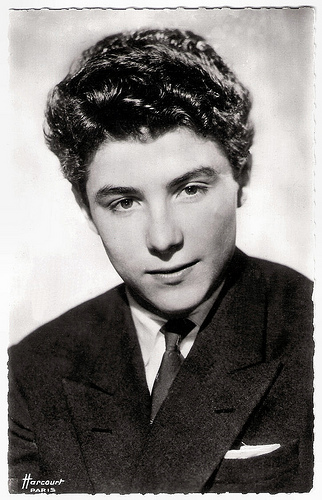
French postcard by Editions du Globe, Paris, no. 262. Photo: Studio Harcourt, Paris.
Sources: RobertoBenzi.com, D.B. DuMonteil (IMDb), Wikipedia (French and Dutch) and .

French postcard. Photo: Rotophoto (?).
Musical whiz kid
Roberto Benzi was born of Italian parents in Marseille, France, in 1937. There his father taught solfege. Roberto's musical gifts, in particular his ‘perfect pitch, were apparent from an extremely young age.
At three years old he began to learn solfege and at four, the piano. He conducted his first concert when he was only six years old. A year later, his parents decided to move to Paris to allow their child the best musical education as possible. Roberto then studied orchestral conducting with André Cluytens and in 1948, the only 11-years-old boy started to work as a orchestra conductor.
The musical whiz kid also appeared in two films during the early 1950s. He had a starring role in Prélude à la gloire/Prelude to Glory (Georges Lacombe, 1949). The film pretended not to be a biography of Benzi, who was named Roberto Luigi in the film. Luigi is a street kid and not a music teacher's son, like Benzi. Luigi is a complete autodidact who meets an old conductor, while Benzi had a musical training since he was 3.
D.B. DuMonteil at IMDb : “Georges Lacombe's film is interesting, enhanced by Claude Renoir's camera work. All that Roberto has to do is act naturally because he plays his own role, even if the story is different. No ham acting, but spontaneity and mainly a phenomenal talent: it is something to see this little boy conducting musicians some of whom could be his grandfather! The raison d'être of the film is the last fifteen minutes when Roberto, after refusing to become a performing animal, conducts a Liszt piece.”
Prélude à la gloire was awarded at the Cannes Film Festival in 1950. The film was followed by L'Appel du destin/Call of Destiny (Georges Lacombe, 1953), in which Benzi costarred with Jean Marais . These films enjoyed an immense success throughout Europe, and inspired several young people to embark upon musical careers.

French postcard by Editions du Globe, Paris, no. 157. Photo: Studio Harcourt, Paris.
Knight in the Order of Orange-Nassau
When Roberto Benzi was fourteen, he went to study at the College of Françonville, near Paris.
In 1959 he conducted with great success the opera Carmen by Georges Bizet at the Paris Opera. Since that time he has been engaged at a great number of opera houses.
At 22, he made is first recording and since then he has recorded numerous works for the Philips label. He was guest conductor of many famous European orchestras, such as the Orchestre National de France, the London Philharmonic Orchestra and the Concertgebouw Orchestra of Amsterdam.
Benzi was the founder and resident conductor of the Orchestre de Bordeaux-Aquitaine from 1972 to 1987. In the Netherlands, he was musical and artistic director of the Arnhem Philharmonic Orchestra (Het Gelders Orkest) from 1989 to 1998, and artistic supervisor and conductor of the National Youth Orchestra (NJO) from 1991 to 1995.
He was married to French mezzo soprano Jane Rhodes who passed away in 2011. Roberto Benzi is a Chevalier (Knight) of the Légion d’honneur, the Ordre National du Mérite, the Palmes Académiques and in the Netherlands, Ridder in de Orde van Oranje-Nassau (Knight in the Order of Orange-Nassau).

French postcard by Editions du Globe, Paris, no. 262. Photo: Studio Harcourt, Paris.
Sources: RobertoBenzi.com, D.B. DuMonteil (IMDb), Wikipedia (French and Dutch) and .
Published on December 12, 2016 22:00
December 11, 2016
Antonio Centa
Between the mid-1930s and 1943, bright and gentle Antonio Centa (1907-1979) was among the most active actors of the Italian cinema. Among female audiences, he was a popular heartthrob in the White Telephone films. The critics praised his performances in Renato Castellani's Un colpo di pistola/A Pistol Shot (1942) and Zazà (1944).

Italian postcard by ASER, no. 100. Photo: Italcine / Foto Ciolfi.

Italian postcard by B.F.F. Edit. (Ballerini e Fratini, Florence), no. 2343. Photo: Italcine / Foto Ciolfi.
P.A. of Primo Carnero
Antonio Centa was born in Maniago, Province of Pordenone, in 1907. During the First World War, his family moved to Ferrara in the Friuli region.
Antonio grew up in the world of ceramics and also started his career here. In 1929 he emigrated to the USA, where he first worked as a ceramist and later worked as the personal assistant of the famous boxer Primo Carnero, who also came from Friuli.
Back in Italy, the bright and charming young man was offered the chance to work in the Italian cinema. He appeared in La luce del mondo/The Light of the World (Gennaro Righelli, 1935). Then, director Gustav Machatý gave him a bigger role in Ballerine/Dancers (1936).
He had his breakthrough with the propaganda film Lo squadrone bianco/White Squadron (Augusto Genina, 1936). From then on, he became one of the most active and notable actors. He was especially popular with the female audience, and was the film partner of such divas as Assia Noris , Alida Valli , Isa Miranda , Doris Duranti , María Denis , and Vivi Gioi .
He appeared in the Telefoni Bianchi comedy La contessa di Parma/The Countess of Parma (Alessandro Blasetti, 1936) opposite Elisa Cegani, the propaganda drama Sotto la croce del sud/Under the Southern Cross (Guido Brignone, 1938), set in Italian-occupied Abyssinia following the recent Italian victory there, and another White telephone comedy, Una moglie in pericolo/A Wife in Danger (Max Neufeld, 1939) with French actress Marie Glory .
With his ironic air, he often embodied the role of the antagonist of the hero. He was thus the rival of Fosco Giachetti in the drama Fari nella nebbia/Headlights in the Fog (Gianni Franciolini, 1942), and of Andrea Checchi and Gino Cervi in Gente dell'aria/Air People (Esodo Pratelli, 1943).
Centa had critically acclaimed performances in Renato Castellani's films Un colpo di pistola/A Pistol Shot (1942) with Assia Noris , and Zazà (1944) with Isa Miranda and based on a script by Alberto Moravia.
In 1939 Centa was forced to lend his voice to his colleague Osvaldo Valenti in the film La vedova/The widow (Goffredo Alessandrini, 1939). The part had originally been assigned to him, but at the last moment it was offered to Valenti although Centa had already the contract in his pocket. Centa was punished for having undermined the mistress of a powerful fascist.

Italian postcard by B.F.F. Edit, no. 4414. Photo: E.N.I.C. (Ente Nazionale Industrie Cinematografiche) / Foto Bragaglia.

Italian postcard by B.F.F. Edit., no. 44130. Photo: Bragaglià / E.N.I.C.

Italian postcard by B.F.F. Edit., no. 4433. Photo: Bragaglia / E.N.I.C.
The absolute gentleman loser
Antonio Centa’s film career broke off in 1943 when the Second World War almost halted the Italian film industry.
After the war his success declined. Italian Wikipedia suggests that the reason that he got less leading roles was either a change in the taste of the Italian audiences or the fact that Centa’s weight had become a bit heavy.
He played leading roles in films like the drama Assunta Spina (Mario Mattoli, 1948) with Anna Magnani , and Ombre sul Canal Grande/Shadows on the Grand Canal (Glauco Pellegrini, 1951), where he finds Isa Pola , but gradually he started to be cast in supporting roles, such in the historical-adventure film Il cavaliere misterioso/The Mysterious Cavalier (Riccardo Freda, 1948) with Vittorio Gassman , and the British-Italian coproduction The Glass Mountain (Henry Cass, 1949).
He could be seen in memorable films like the thrilling French-Italian drama Le salaire de la peur/The Wages of Fear (Henri-Georges Clouzot, 1953) and Una vita difficile/A Difficult Life (Dino Risi, 1961) as the tour leader and mature suitor of Lea Massari.
One of his last films was the comedy La pecora nera/The Black Sheep (Luciano Salce, 1968), starring Vittorio Gassman . In the late 1960s, Centa retired from the cinema and returned to Ferrara, where he ran a restaurant for a while.
Gloria De Antoni and Oreste De Fornari directed a documentary about him, Il perdente gentiluomo: vita e arte di Antonio Centa (The absolute gentleman loser. Life and art of Antonio Centa) produced by the Cineteca del Friuli. Antonio Centa died in 1979, after a car accident near Rovigo, Italy.

Italian postcard by B.F.F. Edit. (Ballerini e Fratini, Florence), no. 2353. Photo: ENIC / Foto Gneme.

Italian postcard by B.F.F. Edit. (Ballerini e Fratini, Florence), no. 201470. Photo: Venturini, Rome.

Italian postcard by ASER (A. Sermiglia Ed. Roma), no. 19. Photo: Ciolfi / Italcine.
Sources: Messagero Veneto (Italian), Wikipedia (Italian and English), and .

Italian postcard by ASER, no. 100. Photo: Italcine / Foto Ciolfi.

Italian postcard by B.F.F. Edit. (Ballerini e Fratini, Florence), no. 2343. Photo: Italcine / Foto Ciolfi.
P.A. of Primo Carnero
Antonio Centa was born in Maniago, Province of Pordenone, in 1907. During the First World War, his family moved to Ferrara in the Friuli region.
Antonio grew up in the world of ceramics and also started his career here. In 1929 he emigrated to the USA, where he first worked as a ceramist and later worked as the personal assistant of the famous boxer Primo Carnero, who also came from Friuli.
Back in Italy, the bright and charming young man was offered the chance to work in the Italian cinema. He appeared in La luce del mondo/The Light of the World (Gennaro Righelli, 1935). Then, director Gustav Machatý gave him a bigger role in Ballerine/Dancers (1936).
He had his breakthrough with the propaganda film Lo squadrone bianco/White Squadron (Augusto Genina, 1936). From then on, he became one of the most active and notable actors. He was especially popular with the female audience, and was the film partner of such divas as Assia Noris , Alida Valli , Isa Miranda , Doris Duranti , María Denis , and Vivi Gioi .
He appeared in the Telefoni Bianchi comedy La contessa di Parma/The Countess of Parma (Alessandro Blasetti, 1936) opposite Elisa Cegani, the propaganda drama Sotto la croce del sud/Under the Southern Cross (Guido Brignone, 1938), set in Italian-occupied Abyssinia following the recent Italian victory there, and another White telephone comedy, Una moglie in pericolo/A Wife in Danger (Max Neufeld, 1939) with French actress Marie Glory .
With his ironic air, he often embodied the role of the antagonist of the hero. He was thus the rival of Fosco Giachetti in the drama Fari nella nebbia/Headlights in the Fog (Gianni Franciolini, 1942), and of Andrea Checchi and Gino Cervi in Gente dell'aria/Air People (Esodo Pratelli, 1943).
Centa had critically acclaimed performances in Renato Castellani's films Un colpo di pistola/A Pistol Shot (1942) with Assia Noris , and Zazà (1944) with Isa Miranda and based on a script by Alberto Moravia.
In 1939 Centa was forced to lend his voice to his colleague Osvaldo Valenti in the film La vedova/The widow (Goffredo Alessandrini, 1939). The part had originally been assigned to him, but at the last moment it was offered to Valenti although Centa had already the contract in his pocket. Centa was punished for having undermined the mistress of a powerful fascist.

Italian postcard by B.F.F. Edit, no. 4414. Photo: E.N.I.C. (Ente Nazionale Industrie Cinematografiche) / Foto Bragaglia.

Italian postcard by B.F.F. Edit., no. 44130. Photo: Bragaglià / E.N.I.C.

Italian postcard by B.F.F. Edit., no. 4433. Photo: Bragaglia / E.N.I.C.
The absolute gentleman loser
Antonio Centa’s film career broke off in 1943 when the Second World War almost halted the Italian film industry.
After the war his success declined. Italian Wikipedia suggests that the reason that he got less leading roles was either a change in the taste of the Italian audiences or the fact that Centa’s weight had become a bit heavy.
He played leading roles in films like the drama Assunta Spina (Mario Mattoli, 1948) with Anna Magnani , and Ombre sul Canal Grande/Shadows on the Grand Canal (Glauco Pellegrini, 1951), where he finds Isa Pola , but gradually he started to be cast in supporting roles, such in the historical-adventure film Il cavaliere misterioso/The Mysterious Cavalier (Riccardo Freda, 1948) with Vittorio Gassman , and the British-Italian coproduction The Glass Mountain (Henry Cass, 1949).
He could be seen in memorable films like the thrilling French-Italian drama Le salaire de la peur/The Wages of Fear (Henri-Georges Clouzot, 1953) and Una vita difficile/A Difficult Life (Dino Risi, 1961) as the tour leader and mature suitor of Lea Massari.
One of his last films was the comedy La pecora nera/The Black Sheep (Luciano Salce, 1968), starring Vittorio Gassman . In the late 1960s, Centa retired from the cinema and returned to Ferrara, where he ran a restaurant for a while.
Gloria De Antoni and Oreste De Fornari directed a documentary about him, Il perdente gentiluomo: vita e arte di Antonio Centa (The absolute gentleman loser. Life and art of Antonio Centa) produced by the Cineteca del Friuli. Antonio Centa died in 1979, after a car accident near Rovigo, Italy.

Italian postcard by B.F.F. Edit. (Ballerini e Fratini, Florence), no. 2353. Photo: ENIC / Foto Gneme.

Italian postcard by B.F.F. Edit. (Ballerini e Fratini, Florence), no. 201470. Photo: Venturini, Rome.

Italian postcard by ASER (A. Sermiglia Ed. Roma), no. 19. Photo: Ciolfi / Italcine.
Sources: Messagero Veneto (Italian), Wikipedia (Italian and English), and .
Published on December 11, 2016 22:00
December 10, 2016
Rolla Norman
Rolla Norman (1889-1971) was a French actor in silent and sound cinema. ‘The Man with Many Faces’ was also a war hero.
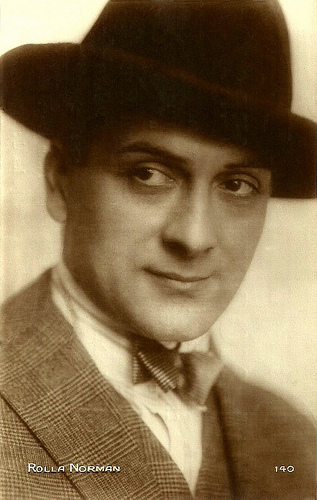
French postcard by Editions Cinémagazine, no. 140.
Film d'Art
Rolla Norman was born as Edouard Charles Normand in Paris in 1889. He had Alsatian parents, who originally were named Nordmann. They Frenchified it to Normand at the Franco-Prussian war of 1870, when they moved to Paris to sell dairy products.
At a young age, Edouard entered the Conservatoire and won First Prize in Drama and Comedy. He adopted the stage name of Rolla Norman – Rolla referred to the title of a poem by Alfred De Musset which he recited at his graduation at the Conservatoire. Refusing an engagement at the Comédie Française, he started acting instead both on stage and in the cinema, from 1908 on.
Supposedly his first part was in the first Film d’Art production, the short silent film L’assassinat du Duc de Guise/The Assassination of the Duke de Guise (André Calmettes, Charles Le Bargy , 1908). He was 19 at the time.
This appearance was followed by more parts in other Film d’Art productions, all directed by André Calmettes: Louis XI, Le roi de Rome/The King of Rome (1909) with Henri Desfontaines, Héliogabale/Heliogabalus (1909), Rigoletto (1909) with Paul Mounet, and Les enfants d’Edouard (1910) with Émile Dehelly .
From 1909 on, Norman also played for such directors as Albert Capellani, Henri Pouctal and Gérard Bourgeois. In 1912 Norman played in his first feature-length film, an adaptation of Alexandre Dumas Père's Les trois mousquetaires/The Three Musketeers (André Calmettes, Henri Pouctal, 1912). In 1914 he played in the serial Le chevalier de Maison-Rouge/The Knight of the Red House (Albert Capellani, 1914) starring Paul Escoffier and also based on a novel by Alexandre Dumas père. This serial had six sections and 60 episodes.
In 1915 Norman joined the armed forces during WW I and worked in the artillery, thereby almost killing his brother-in-laws who were held in POW camps. After the war, in 1919 he met his future wife and they married. Norman pursued his career in silent cinema, starting in 1919 with Sa gosse/Her Kid (Henri Desfontaines, 1919), starring Elmire Vautier .

French postcard by Editions Filma, no. 107. Photo: F. Bixio.
Salammbô
During the early 1920s Rolla Norman appeared in such films as Une fleur dans la ronce/A Flower in the Brambles (Camille de Morlhon, 1920), Le crime des hommes/The Crime of Men (Gaston Roudès, 1923), Le chant de l’amour triomphant/The Song of the triumphant love (Viktor Tourjansky, 1923) with Jean Angelo, Coeurs farouches/Wild hearts (Julien Duvivier, 1924), Credo ou la tragédie de Lourdes/Credo or the Tragedy of Lourdes (Julien Duvivier, 1924), and L’avocat/The lawyer (Gaston Ravel, 1925) with Sylvio de Pedrelli .
In 1924 he had a capital engagement as the male lead in the French super-production Salammbô (Pierre Marodon, 1925), based on the historical novel by Gustave Flaubert. The première took place at the Opéra Garnier in Paris in 1925. A special score was written by Florent Schmitt for the film. In 1991, the film was beautifully restored and presented at the Avignon music festival. Salammbô was presented again at the first Cinémémoire festival in Paris in 1991, with a huge orchestra and a chorus of 80 singers.
After Salammbô, Norman played in the Alexandre Dumas Père adaptation La dame de Monsoreau/The Lady of Monsoreau (René Le Somptier, 1925), starring Geneviève Félix , the prestigious German-Italian coproduction Der Bastard/Il transatlantico/The Bastard (Gennaro Righelli, 1925) starring Maria Jacobini , Jacques Feyder’s touching Gribiche/Mother of Mine (1926) with Jean Forest and Françoise Rosay .
In the next years followed roles in La veine/The vein (René Barberis, 1928) with Sandra Milowanoff , La grande passion/The big passion (André Hugon, 1928) with Lil Dagover , Das letzte Fort/The Last Fort (Kurt aka Curtis Bernhardt, 1929) with Maria Paudler , and Miss Édith, duchesse/Miss Edith, Duchess (Donatien, 1929) with Lucienne Legrand.

French postcard in the Les Vedettes de Cinéma Series by AN, Paris, no. 165. Photo: Sartony.
Hollywood
Around 1930, after sound film had set in, Rolla Norman went to California, where he played in French versions of productions of the First National studio, including Le masque d’Hollywood (Clarence Badger, John Daumery, 1930) - the alternate language version of Show Girl in Hollywood (1930), Lopez, le bandit (John Daumery, 1930) - the French version of The Bad Man (1930), and Contre-enquête (John Daumery, 1930) - the French version of Those Who Dance (1930), all starring Suzy Vernon .
These were followed by L’aviateur (John Daumery, William A. Seiter, 1931) with Douglas Fairbanks jr. (original: The Aviator (1929)), the MGM production Révolte dans la prison (Pàl Fejos, George W. Hill, 1931) which was the French version of The Big House and which starred Charles Boyer , plus the French version of the Buster Keaton comedy Parlor, Bedroom and Bath: Buster se marie (Claude Autant-Lara, Edward Brophy, 1931).
Disillusioned about Hollywood, Norman returned to France and to the French stage and cinema. Until the outbreak of WW II he played in some twenty French sound films, including Échec et mat/Checkmate (Roger Goupillières, 1931) with Dolly Davis , and the Georges Siménon adaptation Le chien jaune/The Yellow Dog (Jean Tarride, 1932).
Norman’s parts became much smaller in the second half of the 1930s. His last part before he fled France, was in the Franco-Dutch coproduction Notre Dame de la Mouise/Our Lady of the Slums (Robert Péguy, 1941). Shooting for the film had started in 1939, but because of the outbreak of the Second World War, it was interrupted and finished in July 1940. Finally the film was released in France in early 1941.
At the end of 1944 Norman was arrested in his house by the French police, as neighbors had suspected him of collaboration. Instead, it came out that when war had broken out, Norman had gone to the States to enlist in the army and then in the OSS, working as a spy, training resistance fighters and preparing the Normandy landing.
In 1946 he was promoted Commander in the Legion of Honour. After the war Norman played small parts in three more films and then retired in 1950. Rolla Norman died in 1971 at Buc, Yvelines, France. He was 82.

French postcard by Editions Cinémagazine, no. 2025.
Sources: Mammodouy, Wikipedia (French), and .

French postcard by Editions Cinémagazine, no. 140.
Film d'Art
Rolla Norman was born as Edouard Charles Normand in Paris in 1889. He had Alsatian parents, who originally were named Nordmann. They Frenchified it to Normand at the Franco-Prussian war of 1870, when they moved to Paris to sell dairy products.
At a young age, Edouard entered the Conservatoire and won First Prize in Drama and Comedy. He adopted the stage name of Rolla Norman – Rolla referred to the title of a poem by Alfred De Musset which he recited at his graduation at the Conservatoire. Refusing an engagement at the Comédie Française, he started acting instead both on stage and in the cinema, from 1908 on.
Supposedly his first part was in the first Film d’Art production, the short silent film L’assassinat du Duc de Guise/The Assassination of the Duke de Guise (André Calmettes, Charles Le Bargy , 1908). He was 19 at the time.
This appearance was followed by more parts in other Film d’Art productions, all directed by André Calmettes: Louis XI, Le roi de Rome/The King of Rome (1909) with Henri Desfontaines, Héliogabale/Heliogabalus (1909), Rigoletto (1909) with Paul Mounet, and Les enfants d’Edouard (1910) with Émile Dehelly .
From 1909 on, Norman also played for such directors as Albert Capellani, Henri Pouctal and Gérard Bourgeois. In 1912 Norman played in his first feature-length film, an adaptation of Alexandre Dumas Père's Les trois mousquetaires/The Three Musketeers (André Calmettes, Henri Pouctal, 1912). In 1914 he played in the serial Le chevalier de Maison-Rouge/The Knight of the Red House (Albert Capellani, 1914) starring Paul Escoffier and also based on a novel by Alexandre Dumas père. This serial had six sections and 60 episodes.
In 1915 Norman joined the armed forces during WW I and worked in the artillery, thereby almost killing his brother-in-laws who were held in POW camps. After the war, in 1919 he met his future wife and they married. Norman pursued his career in silent cinema, starting in 1919 with Sa gosse/Her Kid (Henri Desfontaines, 1919), starring Elmire Vautier .

French postcard by Editions Filma, no. 107. Photo: F. Bixio.
Salammbô
During the early 1920s Rolla Norman appeared in such films as Une fleur dans la ronce/A Flower in the Brambles (Camille de Morlhon, 1920), Le crime des hommes/The Crime of Men (Gaston Roudès, 1923), Le chant de l’amour triomphant/The Song of the triumphant love (Viktor Tourjansky, 1923) with Jean Angelo, Coeurs farouches/Wild hearts (Julien Duvivier, 1924), Credo ou la tragédie de Lourdes/Credo or the Tragedy of Lourdes (Julien Duvivier, 1924), and L’avocat/The lawyer (Gaston Ravel, 1925) with Sylvio de Pedrelli .
In 1924 he had a capital engagement as the male lead in the French super-production Salammbô (Pierre Marodon, 1925), based on the historical novel by Gustave Flaubert. The première took place at the Opéra Garnier in Paris in 1925. A special score was written by Florent Schmitt for the film. In 1991, the film was beautifully restored and presented at the Avignon music festival. Salammbô was presented again at the first Cinémémoire festival in Paris in 1991, with a huge orchestra and a chorus of 80 singers.
After Salammbô, Norman played in the Alexandre Dumas Père adaptation La dame de Monsoreau/The Lady of Monsoreau (René Le Somptier, 1925), starring Geneviève Félix , the prestigious German-Italian coproduction Der Bastard/Il transatlantico/The Bastard (Gennaro Righelli, 1925) starring Maria Jacobini , Jacques Feyder’s touching Gribiche/Mother of Mine (1926) with Jean Forest and Françoise Rosay .
In the next years followed roles in La veine/The vein (René Barberis, 1928) with Sandra Milowanoff , La grande passion/The big passion (André Hugon, 1928) with Lil Dagover , Das letzte Fort/The Last Fort (Kurt aka Curtis Bernhardt, 1929) with Maria Paudler , and Miss Édith, duchesse/Miss Edith, Duchess (Donatien, 1929) with Lucienne Legrand.

French postcard in the Les Vedettes de Cinéma Series by AN, Paris, no. 165. Photo: Sartony.
Hollywood
Around 1930, after sound film had set in, Rolla Norman went to California, where he played in French versions of productions of the First National studio, including Le masque d’Hollywood (Clarence Badger, John Daumery, 1930) - the alternate language version of Show Girl in Hollywood (1930), Lopez, le bandit (John Daumery, 1930) - the French version of The Bad Man (1930), and Contre-enquête (John Daumery, 1930) - the French version of Those Who Dance (1930), all starring Suzy Vernon .
These were followed by L’aviateur (John Daumery, William A. Seiter, 1931) with Douglas Fairbanks jr. (original: The Aviator (1929)), the MGM production Révolte dans la prison (Pàl Fejos, George W. Hill, 1931) which was the French version of The Big House and which starred Charles Boyer , plus the French version of the Buster Keaton comedy Parlor, Bedroom and Bath: Buster se marie (Claude Autant-Lara, Edward Brophy, 1931).
Disillusioned about Hollywood, Norman returned to France and to the French stage and cinema. Until the outbreak of WW II he played in some twenty French sound films, including Échec et mat/Checkmate (Roger Goupillières, 1931) with Dolly Davis , and the Georges Siménon adaptation Le chien jaune/The Yellow Dog (Jean Tarride, 1932).
Norman’s parts became much smaller in the second half of the 1930s. His last part before he fled France, was in the Franco-Dutch coproduction Notre Dame de la Mouise/Our Lady of the Slums (Robert Péguy, 1941). Shooting for the film had started in 1939, but because of the outbreak of the Second World War, it was interrupted and finished in July 1940. Finally the film was released in France in early 1941.
At the end of 1944 Norman was arrested in his house by the French police, as neighbors had suspected him of collaboration. Instead, it came out that when war had broken out, Norman had gone to the States to enlist in the army and then in the OSS, working as a spy, training resistance fighters and preparing the Normandy landing.
In 1946 he was promoted Commander in the Legion of Honour. After the war Norman played small parts in three more films and then retired in 1950. Rolla Norman died in 1971 at Buc, Yvelines, France. He was 82.

French postcard by Editions Cinémagazine, no. 2025.
Sources: Mammodouy, Wikipedia (French), and .
Published on December 10, 2016 22:00
December 9, 2016
Imported from the USA: Douglas Fairbanks Jr.
Handsome and distinguished, Douglas Fairbanks Jr. (1909-2000) was much more than the son of his superstar father. He was a bright, multi-talent, who excelled in sports and sculpting, was involved in business and was knighted for his war efforts as a lieutenant. And he acted in approximately 100 films or TV shows.

German postcard by Ross Verlag, no. 7297/1, 1932-1933. Photo: First National Pictures.

Italian postcard by B.F.F. Edit. (Casa Editr. Ballerini & Fratini, Firenze), no. 2108. Photo: Paramount Films.

Dutch postcard by J.S.A., no. 192. Photo: Universal Film Booking Office.

Dutch postcard by 't Sticht, Utrecht, no. 1005. Photo: Universal International.
Noblesse oblige
Douglas Elton Ulman Fairbanks Junior was born in New York City in 1909 as the only child of the future Swashbuckler of silent films, Douglas Fairbanks , and Beth Sully, the daughter of a very wealthy cotton mogul. His parents divorced when he was nine years old, and both remarried.
He lived with his mother in New York, California, Paris and London. He soon proved a gifted boy. Guy Bellinger at IMDb : "Douglas Elton Ulman - better known as Douglas Fairbanks Jr. - never really intended to take up acting as a career. However, the environment he was born into and the circumstances naturally led him to be a thespian. Noblesse oblige."
'Doug' excelled at sports, notably during his stay at the Military Academy in 1919. Later his role in Claude Autant-Lara's L'athlète incomplete/Love Is a Racket (1932) illustrated these abilities. He also excelled academically, and attended the Lycée Janson de Sailly in Paris, where he had followed his divorced mother.
Very early in his life he developed a taste for the arts as well and became a painter and sculptor. Not content to limiting himself to just one field, he became involved in business, in fields as varied as mining, hotel management, owning a chain of bowling alleys and a firm that manufactured popcorn.
During World War II he headed London's Douglas Voluntary Hospital (an establishment taking care of war refugees), was President Franklin D. Roosevelt's special envoy for the Special Mission to South America in 1940 before becoming a lieutenant in the Navy and taking part in the Allies' landing in Sicily and Elba in 1943.
Fairbanks held the Silver Star and the Legion of Merit with V for valour in combat device from the U.S. government for his combat service. In 1949, he was created an honorary Knight Commander of the Most Excellent Order of the British Empire. A fervent Anglophile, he often entertained Queen Elizabeth II and Prince Philip in his London mansion, 'The Boltons'. In 1954, Fairbanks was promoted to the rank of captain in the Navy.

French postcard in the Les Vedettes de Cinéma series by A.N. Paris, no. 71. Photo: Paramount.

Austrian postcard by Iris Verlag, no. 635. Photo: Fanamet Film.

German postcard by Ross Verlag, Berlin, no. 1242/1, 1927-1928. Photo: Paramount Film.

British postcard in the Film Weekly series, London.

With Joan Crawford. German postcard by Ross Verlag, Berlin, no. 4628/1, 1929-1930. Photo: Metro-Goldwyn-Mayer.
The toast of the town
Douglas Fairbanks Jr. began his film career at the age of 13. Largely on the basis of his father's name, Fairbanks, Jr. was given a contract with Paramount Pictures.
He debuted in the silent comedy Stephen Steps Out (Joseph Henabery, 1923) but the film flopped and his career stagnated despite a critically acclaimed role in Stella Dallas (Henry King, 1925), in which he sported a moustache to play a rich husband. In 1929, he took to the stage, and appeared in Young Woodley and Saturday's Children in Los Angeles. He impressed his father, his stepmother Mary Pickford, and Charlie Chaplin , who encouraged him to continue with acting.
Things really picked up when he appeared in the silent drama Our Modern Maidens (Jack Conway, 1929) opposite Lucille Le Sueur, a young starlet who was soon to become better known as Joan Crawford. They married and the young couple became the toast of the town.
He demonstrated a well-modulated speaking voice and good parts followed in early sound films. He was an ace pilot in the World War I drama The Dawn Patrol (Howard Hawks, 1930), and the hapless partner of Edward G. Robinson in Little Caesar (Mervyn Leroy, 1931). His separation and 1933 divorce from Joan Crawford gained even more publicity than their courtship and marriage.
The 1930s were a fruitful period for Fairbanks who easily played a wide variety of roles. He was good as the mad Tsar in The Rise of Catherine the Great (Paul Czinner, 1934). He was even better as the irresistible villain Rupert of Hentzau in The Prisoner of Zenda (John Cromwell, 1937) starring Ronald Colman. But his most memorable role is probably that of the British soldier in Gunga Din (George Stevens, 1939) with Cary Grant and Victor McLaglen .
Till then Fairbanks had carefully tried to avoid comparisons with his father, but after Doug Senior's death, he proved himself zestful as a romantic adventurer. In films like The Corsican Brothers (Gregory Ratoff, 1942), The Exile (Max Ophüls, 1947) and Sinbad the Sailor (Richard Wallace,1947) the spirit of his father seemed to glow within him.
In the early 1950s, Fairbanks retired from the cinema and moved to London. He produced and was a co-writer of several films. Between 1954 and 1956 he was the executive producer and host of a popular television anthology show, Douglas Fairbanks, Jr., Presents . Despite a moving part opposite Fred Astaire and Melvyn Douglas in Ghost Story (John Irvin, 1981), he did not appear in a major film.
He published two volumes of autobiography - The Salad Days (1988) and A Hell of a War (1993). Douglas Fairbanks, Jr. also collaborated with Richard Schickel on the illustrated survey of Fairbanks Sr. and Jr. called The Fairbanks Album (1975) and with Jeffrey Vance on a critical study/biography of Fairbanks Sr. ultimately published as Douglas Fairbanks (2008).
He was married three times. After his divorce from Joan Crawford, he was married till her death in 1988 to Mary Lee Eppling, with whom he had three daughters, and from 1991 till his death to Vera Fairbanks. At the age of 90, Douglas Fairbanks Jr. died of a heart attack in 2000. Guy Bellinger: "Now a legend himself, Douglas Fairbanks Jr. left this world with the satisfaction of having lived up to the Fairbanks name at the end of a life nobody could call 'wasted'."b

British postcard in the Filmshots series by Film Weekly. Photo: Warner. Publicity still for The Narrow Corner (Alfred E. Green, 1933) with Dudley Digges, Douglas Fairbanks Jr. and Everett Brown.

British postcard by Valentine's, no. 5904 N. Photo: London Films. Publicity still for The Rise of Catherine the Great (Paul Czinner, 1934).

German postcard by Netter's Star Verlag, Berlin. Photo: RKO Radio Film. Publicity still for Gunga Din (George Stevens, 1939).

German postcard by Netter's Star Verlag, Berlin. Photo: Universal International. Publicity still for The Exile (Max Ophüls, 1947).
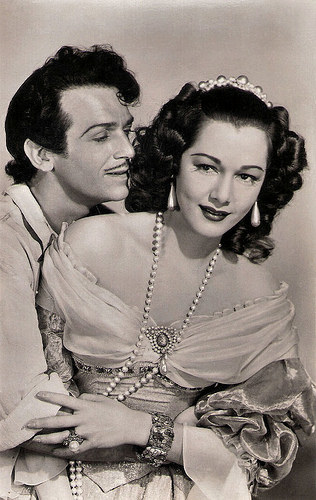
Spanish postcard by Sobe, no. 452. Photo: publicity still for The Exile (Max Ophüls, 1947) with Maria Montez .
Sources: (IMDb), Hal Erickson (AllMovie), New York Times, The Telegraph, Wikipedia and .

German postcard by Ross Verlag, no. 7297/1, 1932-1933. Photo: First National Pictures.

Italian postcard by B.F.F. Edit. (Casa Editr. Ballerini & Fratini, Firenze), no. 2108. Photo: Paramount Films.

Dutch postcard by J.S.A., no. 192. Photo: Universal Film Booking Office.

Dutch postcard by 't Sticht, Utrecht, no. 1005. Photo: Universal International.
Noblesse oblige
Douglas Elton Ulman Fairbanks Junior was born in New York City in 1909 as the only child of the future Swashbuckler of silent films, Douglas Fairbanks , and Beth Sully, the daughter of a very wealthy cotton mogul. His parents divorced when he was nine years old, and both remarried.
He lived with his mother in New York, California, Paris and London. He soon proved a gifted boy. Guy Bellinger at IMDb : "Douglas Elton Ulman - better known as Douglas Fairbanks Jr. - never really intended to take up acting as a career. However, the environment he was born into and the circumstances naturally led him to be a thespian. Noblesse oblige."
'Doug' excelled at sports, notably during his stay at the Military Academy in 1919. Later his role in Claude Autant-Lara's L'athlète incomplete/Love Is a Racket (1932) illustrated these abilities. He also excelled academically, and attended the Lycée Janson de Sailly in Paris, where he had followed his divorced mother.
Very early in his life he developed a taste for the arts as well and became a painter and sculptor. Not content to limiting himself to just one field, he became involved in business, in fields as varied as mining, hotel management, owning a chain of bowling alleys and a firm that manufactured popcorn.
During World War II he headed London's Douglas Voluntary Hospital (an establishment taking care of war refugees), was President Franklin D. Roosevelt's special envoy for the Special Mission to South America in 1940 before becoming a lieutenant in the Navy and taking part in the Allies' landing in Sicily and Elba in 1943.
Fairbanks held the Silver Star and the Legion of Merit with V for valour in combat device from the U.S. government for his combat service. In 1949, he was created an honorary Knight Commander of the Most Excellent Order of the British Empire. A fervent Anglophile, he often entertained Queen Elizabeth II and Prince Philip in his London mansion, 'The Boltons'. In 1954, Fairbanks was promoted to the rank of captain in the Navy.

French postcard in the Les Vedettes de Cinéma series by A.N. Paris, no. 71. Photo: Paramount.

Austrian postcard by Iris Verlag, no. 635. Photo: Fanamet Film.

German postcard by Ross Verlag, Berlin, no. 1242/1, 1927-1928. Photo: Paramount Film.

British postcard in the Film Weekly series, London.

With Joan Crawford. German postcard by Ross Verlag, Berlin, no. 4628/1, 1929-1930. Photo: Metro-Goldwyn-Mayer.
The toast of the town
Douglas Fairbanks Jr. began his film career at the age of 13. Largely on the basis of his father's name, Fairbanks, Jr. was given a contract with Paramount Pictures.
He debuted in the silent comedy Stephen Steps Out (Joseph Henabery, 1923) but the film flopped and his career stagnated despite a critically acclaimed role in Stella Dallas (Henry King, 1925), in which he sported a moustache to play a rich husband. In 1929, he took to the stage, and appeared in Young Woodley and Saturday's Children in Los Angeles. He impressed his father, his stepmother Mary Pickford, and Charlie Chaplin , who encouraged him to continue with acting.
Things really picked up when he appeared in the silent drama Our Modern Maidens (Jack Conway, 1929) opposite Lucille Le Sueur, a young starlet who was soon to become better known as Joan Crawford. They married and the young couple became the toast of the town.
He demonstrated a well-modulated speaking voice and good parts followed in early sound films. He was an ace pilot in the World War I drama The Dawn Patrol (Howard Hawks, 1930), and the hapless partner of Edward G. Robinson in Little Caesar (Mervyn Leroy, 1931). His separation and 1933 divorce from Joan Crawford gained even more publicity than their courtship and marriage.
The 1930s were a fruitful period for Fairbanks who easily played a wide variety of roles. He was good as the mad Tsar in The Rise of Catherine the Great (Paul Czinner, 1934). He was even better as the irresistible villain Rupert of Hentzau in The Prisoner of Zenda (John Cromwell, 1937) starring Ronald Colman. But his most memorable role is probably that of the British soldier in Gunga Din (George Stevens, 1939) with Cary Grant and Victor McLaglen .
Till then Fairbanks had carefully tried to avoid comparisons with his father, but after Doug Senior's death, he proved himself zestful as a romantic adventurer. In films like The Corsican Brothers (Gregory Ratoff, 1942), The Exile (Max Ophüls, 1947) and Sinbad the Sailor (Richard Wallace,1947) the spirit of his father seemed to glow within him.
In the early 1950s, Fairbanks retired from the cinema and moved to London. He produced and was a co-writer of several films. Between 1954 and 1956 he was the executive producer and host of a popular television anthology show, Douglas Fairbanks, Jr., Presents . Despite a moving part opposite Fred Astaire and Melvyn Douglas in Ghost Story (John Irvin, 1981), he did not appear in a major film.
He published two volumes of autobiography - The Salad Days (1988) and A Hell of a War (1993). Douglas Fairbanks, Jr. also collaborated with Richard Schickel on the illustrated survey of Fairbanks Sr. and Jr. called The Fairbanks Album (1975) and with Jeffrey Vance on a critical study/biography of Fairbanks Sr. ultimately published as Douglas Fairbanks (2008).
He was married three times. After his divorce from Joan Crawford, he was married till her death in 1988 to Mary Lee Eppling, with whom he had three daughters, and from 1991 till his death to Vera Fairbanks. At the age of 90, Douglas Fairbanks Jr. died of a heart attack in 2000. Guy Bellinger: "Now a legend himself, Douglas Fairbanks Jr. left this world with the satisfaction of having lived up to the Fairbanks name at the end of a life nobody could call 'wasted'."b

British postcard in the Filmshots series by Film Weekly. Photo: Warner. Publicity still for The Narrow Corner (Alfred E. Green, 1933) with Dudley Digges, Douglas Fairbanks Jr. and Everett Brown.

British postcard by Valentine's, no. 5904 N. Photo: London Films. Publicity still for The Rise of Catherine the Great (Paul Czinner, 1934).

German postcard by Netter's Star Verlag, Berlin. Photo: RKO Radio Film. Publicity still for Gunga Din (George Stevens, 1939).

German postcard by Netter's Star Verlag, Berlin. Photo: Universal International. Publicity still for The Exile (Max Ophüls, 1947).

Spanish postcard by Sobe, no. 452. Photo: publicity still for The Exile (Max Ophüls, 1947) with Maria Montez .
Sources: (IMDb), Hal Erickson (AllMovie), New York Times, The Telegraph, Wikipedia and .
Published on December 09, 2016 22:00
December 8, 2016
EFSP's Dazzling Dozen: Divas
Danish Asta Nielsen was the first European film star, but the first diva of the silent cinema was an Italian actress, Lyda Borelli. Her ecstatic and aristocratic performance, mixing grand gesture with delicate small details, her elegant attire and her long blond hair caused a craze. In the 1910s girls dyed their hair, went on diets and strove to imitate her twisted postures. This phenomenon was described in Italy as Borellismo. Soon other Italian actresses like Francesca Bertini, Pina Menichelli and Rina de Liguoro also swept across the screen. Their film dramas of the 1910s and early 1920s were full of decadence and outrageous emotion, and they offered an extravaganza of costumes and gestures. Ivo Blom selected for EFSP 12 dazzling postcards of these divas who gave the early Italian cinema grandeur, sensuality and style.

Italian postcard, no. 118. Photo Ed. Soc. Anon. It. Bettini, Roma.
Lyda Borelli (1887-1959) was already an acclaimed stage actress before she became the first diva of the Italian silent cinema. The fascinating film star caused a craze among female fans called 'Borellismo'.

Italian postcard. Ufficio Rev. Stampa, no.894, Milano 25-5-1917. Portrait: Tito Corbella.
Francesca Bertini (1892-1985) had already a prolific career in one-, two- and three-reelers for the Italian companies Cines and Celio, before she received diva status in 1914. In 1921 she married count Paul Cartier and retired. After their divorce, she returned to the film sets. Her last film role was that of a nun in Bernardo Bertolucci's Novecento/1900 (1977).

Italian postcard by TM.
Fascinating and enigmatic Pina Menichelli (1890-1984) was the most bizarre Italian diva of the silent era. With her contorted postures and disdainful expression, she impersonated the striking femme fatale.

Italian postcard. Photo Ed. Emilio Sommariva, Milano, no. 1.
Polish actress Diana Karenne (1888-1940) was also one of the divas of Italian silent cinema. Between 1916 and 1920, Karenne fascinated audiences with her eccentric dresses and make-up, and with her primadonna behaviour. Afterwards she had a career in the German and French silent cinema.

Italian postcard. U.C.I., no. 942. Rina De Liguoro in the Italian silent film Quello che non muore (Wladimiro De Liguoro, 1926).
Rina De Liguoro (1892-1966) was the last diva of the Italian silent cinema of the 1920s. She had her breakthrough in 1924 as the sensual, untamed Roman empress Messalina, and the beautiful countess continued her glittering career in such epics as Quo Vadis (1924), Casanova (1927) and Cecil B. De Mille's notorious Madam Satan (1930).

Italian postcard. Photo DM.
Polish singer and actress Helena Makowska aka Elena Makowska (1893-1964) was a beautiful diva of the Italian silent cinema in the 1910s. During the 1920s she moved to Berlin and also became a star of the German cinema.

Italian postcard by Ed. A. Traldi, Milano, no. 329. Photo Fontana, Roma.
Polish actress Soava Gallone (1880-1957) was directed in one silent film after another by her husband, Carmine Gallone. From the mid-1910s onwards, the diva starred in many Italian films as the 'femme fragile'.

Italian postcard by G.B. Falci, Milano, no. 154. Maria Jacobini with Carmela Bonicatti ( Carmen Boni ) in La preda (Guglielmo Zorzi, 1921).
Among the Italian divas, Maria Jacobini (1892-1944) was an island of serenity, as film historian Vittorio Martinelli expressed it. She was the personification of goodness, of simple love. Her weapon was her sweet and gracious smile. However, in some Italian and later also in German films, she could as well play the vivacious lady, the femme fatale, the comedienne, the hysterical victim, or the suffering mother or wife.

Italian postcard by Ed. Vettori, Bologna. Foto Pinto, Roma.
Versatile actress Leda Gys (1892-1957) was the only Italian diva who never played vamp roles and the only one whose career lasted until the advent of sound films. She starred in some 80 dramas, comedies, action thrillers and even westerns of the Italian and Spanish silent cinema. Her claim to fame came with the film Christus (1916), shot in Egypt and Palestine, where Gys performed the Madonna.

Italian postcard by Foto Ebano, no. 1.
Elena Sangro (1896-1969) was one of the main actresses of the Italian cinema of the 1920s. In spite of the general film crisis then, she made one film after another. She was also one of the first female directors and she had a famous affair with the 64-year-old poet Gabriele D'Annunzio.

Italian postcard by Ballerini & Fratini, Firenze, no. 529. Photo Scoffone. Italia Almirante in L'arzigogolo/The Court Jester (Mario Almirante, 1924), an adaptation of the play by Sem Benelli.
Italia Almirante (1890-1941) was one of the great divas of the Italian silent cinema. She starred in the classic epic Cabiria (1914). In the following decades she worked with some of the most important Italian directors of the silent era, including Roberto Roberti, Augusto Genina and Giovanni Pastrone. From 1935 on she played on stage in Brazil, where she suddenly died, when she was bitten by a poisonous insect.

Italian postcard by Ed. A. Traldi, Roma. Photo Pinto, Roma.
Hesperia (1885-1959) was one of the Italian divas of the silent screen. She often worked with director Baldassarre Negroni, who later became her husband.
This is a post for Postcard Friendship Friday, hosted by Beth at the The Best Hearts are Crunchy. You can visit her by clicking on the button below.

Source: Silents, Please!.

Italian postcard, no. 118. Photo Ed. Soc. Anon. It. Bettini, Roma.
Lyda Borelli (1887-1959) was already an acclaimed stage actress before she became the first diva of the Italian silent cinema. The fascinating film star caused a craze among female fans called 'Borellismo'.

Italian postcard. Ufficio Rev. Stampa, no.894, Milano 25-5-1917. Portrait: Tito Corbella.
Francesca Bertini (1892-1985) had already a prolific career in one-, two- and three-reelers for the Italian companies Cines and Celio, before she received diva status in 1914. In 1921 she married count Paul Cartier and retired. After their divorce, she returned to the film sets. Her last film role was that of a nun in Bernardo Bertolucci's Novecento/1900 (1977).

Italian postcard by TM.
Fascinating and enigmatic Pina Menichelli (1890-1984) was the most bizarre Italian diva of the silent era. With her contorted postures and disdainful expression, she impersonated the striking femme fatale.

Italian postcard. Photo Ed. Emilio Sommariva, Milano, no. 1.
Polish actress Diana Karenne (1888-1940) was also one of the divas of Italian silent cinema. Between 1916 and 1920, Karenne fascinated audiences with her eccentric dresses and make-up, and with her primadonna behaviour. Afterwards she had a career in the German and French silent cinema.

Italian postcard. U.C.I., no. 942. Rina De Liguoro in the Italian silent film Quello che non muore (Wladimiro De Liguoro, 1926).
Rina De Liguoro (1892-1966) was the last diva of the Italian silent cinema of the 1920s. She had her breakthrough in 1924 as the sensual, untamed Roman empress Messalina, and the beautiful countess continued her glittering career in such epics as Quo Vadis (1924), Casanova (1927) and Cecil B. De Mille's notorious Madam Satan (1930).

Italian postcard. Photo DM.
Polish singer and actress Helena Makowska aka Elena Makowska (1893-1964) was a beautiful diva of the Italian silent cinema in the 1910s. During the 1920s she moved to Berlin and also became a star of the German cinema.

Italian postcard by Ed. A. Traldi, Milano, no. 329. Photo Fontana, Roma.
Polish actress Soava Gallone (1880-1957) was directed in one silent film after another by her husband, Carmine Gallone. From the mid-1910s onwards, the diva starred in many Italian films as the 'femme fragile'.

Italian postcard by G.B. Falci, Milano, no. 154. Maria Jacobini with Carmela Bonicatti ( Carmen Boni ) in La preda (Guglielmo Zorzi, 1921).
Among the Italian divas, Maria Jacobini (1892-1944) was an island of serenity, as film historian Vittorio Martinelli expressed it. She was the personification of goodness, of simple love. Her weapon was her sweet and gracious smile. However, in some Italian and later also in German films, she could as well play the vivacious lady, the femme fatale, the comedienne, the hysterical victim, or the suffering mother or wife.

Italian postcard by Ed. Vettori, Bologna. Foto Pinto, Roma.
Versatile actress Leda Gys (1892-1957) was the only Italian diva who never played vamp roles and the only one whose career lasted until the advent of sound films. She starred in some 80 dramas, comedies, action thrillers and even westerns of the Italian and Spanish silent cinema. Her claim to fame came with the film Christus (1916), shot in Egypt and Palestine, where Gys performed the Madonna.

Italian postcard by Foto Ebano, no. 1.
Elena Sangro (1896-1969) was one of the main actresses of the Italian cinema of the 1920s. In spite of the general film crisis then, she made one film after another. She was also one of the first female directors and she had a famous affair with the 64-year-old poet Gabriele D'Annunzio.

Italian postcard by Ballerini & Fratini, Firenze, no. 529. Photo Scoffone. Italia Almirante in L'arzigogolo/The Court Jester (Mario Almirante, 1924), an adaptation of the play by Sem Benelli.
Italia Almirante (1890-1941) was one of the great divas of the Italian silent cinema. She starred in the classic epic Cabiria (1914). In the following decades she worked with some of the most important Italian directors of the silent era, including Roberto Roberti, Augusto Genina and Giovanni Pastrone. From 1935 on she played on stage in Brazil, where she suddenly died, when she was bitten by a poisonous insect.

Italian postcard by Ed. A. Traldi, Roma. Photo Pinto, Roma.
Hesperia (1885-1959) was one of the Italian divas of the silent screen. She often worked with director Baldassarre Negroni, who later became her husband.
This is a post for Postcard Friendship Friday, hosted by Beth at the The Best Hearts are Crunchy. You can visit her by clicking on the button below.

Source: Silents, Please!.
Published on December 08, 2016 22:00
Paul van Yperen's Blog
- Paul van Yperen's profile
- 13 followers
Paul van Yperen isn't a Goodreads Author
(yet),
but they
do have a blog,
so here are some recent posts imported from
their feed.



